Squash team takes 2nd in nation
This past season, the squash team had one of its most successful runs in recent memory. Led by a competitive group of upperclassmen, the team finished the season 15-2, with only losses to the Episcopal Academy and the Kent School in the finals of High School Nationals, the premier tournament for high school teams in squash.
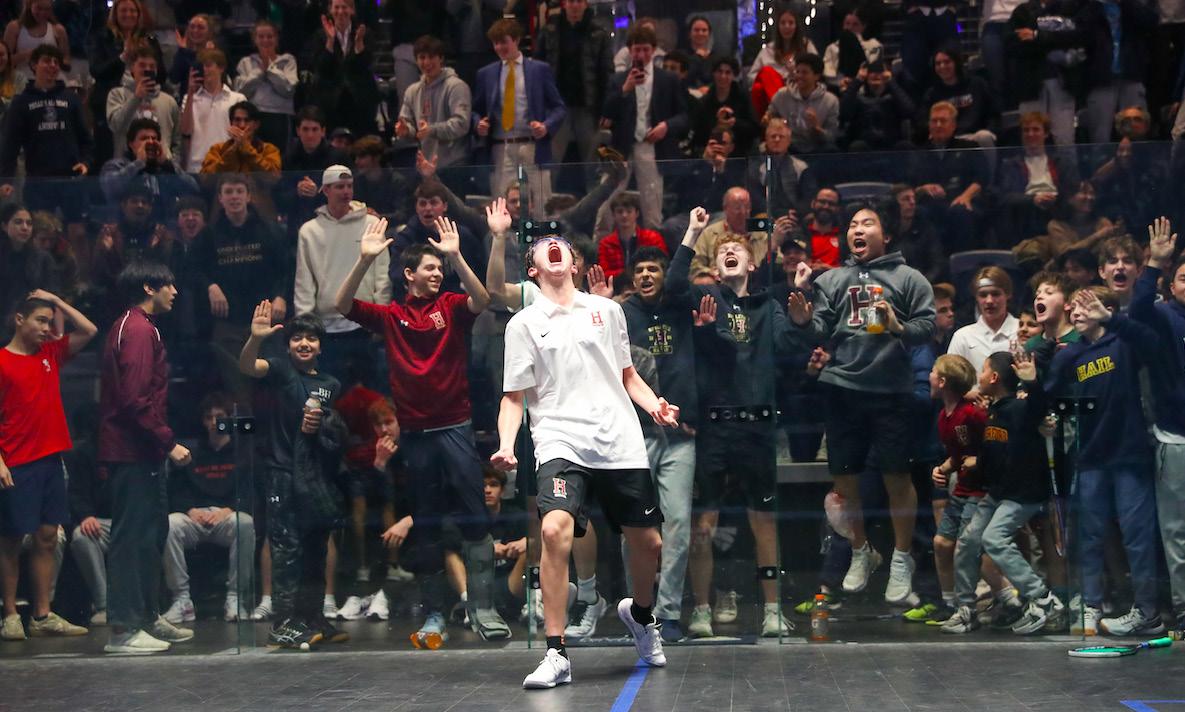
“I actually feel like this year we got ev-
ery little bit out of ourselves,” Head Squash Coach Alex Stait said. “Last year I felt like we could have done a little bit better in the [semifinals] in Nationals—I didn’t feel like that this year.”
The team’s captains, Sixth Formers Owen Yu and Matthew Kang, played an integral role in maintaining a tempo for the season, and keeping the chemistry of the team strong.

“I can’t speak highly enough of them,” Coach Stait said. “One of our players was a little frustrated with one of our other players, saying, ‘Oh, he should have done this, [he] should have done that, and Owen instantly said to him, ‘No. We don’t do that. There’s no negativity.’ And I think that just sums both of them up.”
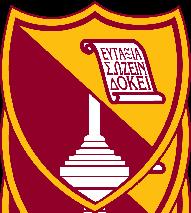
Not only have the captains played a key role in maintaining a healthy team spirit, but
they have played their hardest when it matters most.
“[During nationals] Matthew Kang really just dug one out,” Coach Stait said. “I mean, the boys named him Mr. Nationals because every year he steps up when he needs to.”
con’t on p. 27
Sixth Formers and faculty debate attendance amid growing absences
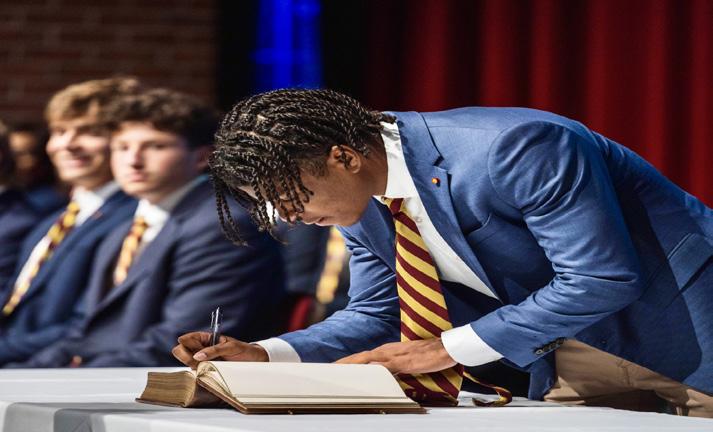
For the past several months, students have been walking on a tightrope throughout Wilson Hall and even off campus. The administration has pushed a stricter regime with a record number of tardies, 46, surrounding one particular issue: attendance.


Since the inception of the more heavily enforced crackdown on attendance in September, students are met with seemingly constant reminders from teachers. An extensive list sent by the Dean of Students Mr. Kolade two weeks ago saw more than 20 Sixth Formers, among other underclassmen, sit silently in Ball Auditorium for an hour-long detention. Despite the drop of the
hammer, this effort from the administration has seen opposite effects.
better being a bit late to class and going out on weeknights, something I’ve never done before.”
On Monday, February 13, 2023, more than half the Sixth Form observed their selfproclaimed “Senior Skip Day,” resulting in an all-too-familiar Ball Auditorium being met again with nearly 50 seventeen and eighteen-year-old Sixth Formers the following Wednesday. While “Senior Skip Day” may have been almost a month ago, lateness and even skip days have been more frequent for some Sixth Formers.
time in the morning. Whether it is traffic or kids starting to cut some slack, I don’t know, but what I can say is that collectively we should be striving to be better,” Student Body President Luka Sekulić said. Administration and student leaders insist on keeping up with current policies surrounding attendance, but some students have their own reasons.
con’t on p. 4
“It feels like it doesn’t matter as much,” Sixth Former Ronan Wood said. “It’s much harder to keep staying motivated, so I feel
“As a school, however, we’ve had a number of detentions just in the past two months because kids aren’t showing up to class on
USSQUASH
· March 2023 · Volume 90, No. 6 · thsindex.org the index The student voice since 1888
Jack Elrani ’27 celebrates with fans and team after 4-3 victory over Saint Andrew’s Florida, February 25, 2023.
The Haverford School · Haverford, PA 19041
Ethan chan ’23
Casey Williams ’24
Discussing police violence, p. 3 COMMUNICATIONS WWI Trials, p. 15 COMMUNICATIONS Honor Council, p. 3 COMMUNICATIONS Lacrosse, p. 25 MR. JIM ROESE
“It feels like it doesn’t matter as much. It’s much harder to keep staying motivated.”
RONAN WOOD ’23
the index
2022–2023 Staff
Jingyuan Chen ’23
Editor-in-Chief
Joey Kauffman ’23
Editor-in-Chief
Connor Pinsk ’23
Editor-in-Chief
Ethan Chan ’23
Senior Managing Editor
Owen Yu ’23
Senior Managing Editor
Ethan Lee ’24
Managing Editor
Adiyan Nayak ’24
Managing Editor
Christopher Schwarting ’24
Managing Editor
Casey Williams ’24
News Editor
Arsh Aggarwal ’24
Features Editor
Ian Rosenzweig ’24
Academics Editor
Tripp Ronon ’24
Neighborhood Editor
Connor Simpkins ’25
Campus Opinions Editor
Charlie Kiedel ’24
Off-Campus Opinions Editor
Russel Yoh ’24
Arts Editor
Tate Conklin ’24
Sports Editor
Pierce Laveran ’24
Photography Editor
Ms. Emily Harnett
Faculty Advisor
Mr. Thomas Stambaugh
Faculty Advisor
The Index is a student-run publication of the Haverford School that does more than bring news: it provides the diverse perspectives of the Haverford student body. It is an outlet for student writers to take stands on issues they deem important. It chronicles the daily struggles and accomplishments of the Haverford community. The Index also provides a forum for discussion of pertinent issues, such as student culture, academic policy, and Haverford’s place in world affairs. The Index presents new ideas and aspires to influence constructive change.
All opinions and viewpoints expressed herein do not necessarily reflect those of The Index or the school. The Index is designed and produced digitally. Photographs may be retouched. Submissions and letters to the editors regarding any and all articles are welcomed at index@haverford.org

The Index, a member of the Columbia Scholastic Press Association, is composed using the applications of Google Suite and Adobe Creative Cloud. Its surveys are conducted via Google Forms and are advertised on email to current Haverford students. Graphic designs are created by Index staff via Canva. Southern Dutchess News prints 200-400 copies of each issue, and its editorial staff distributes them in the Upper School on the day of release. The Index serves the needs of a total school population of 1152 community members, consisting of 952 students and 200 faculty and staff members.
Contact The Index: 450 Lancaster Ave, Haverford, PA 19041 index@haverford.org
Twitter: @Haverford_Index
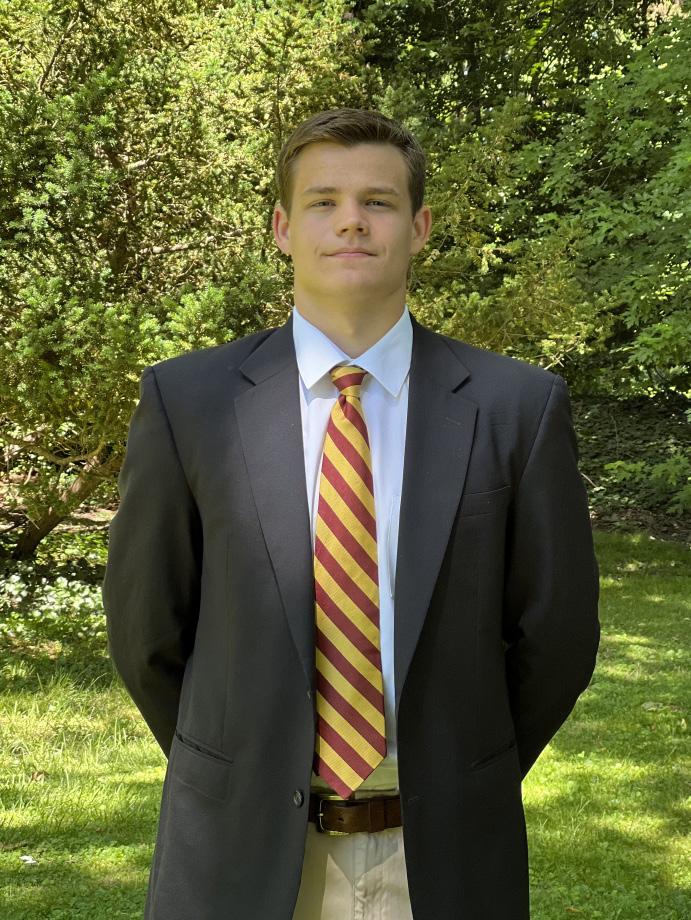
Instagram: @Haverford_Index
Volume 94, No. 6 - March 9, 2023
editorial
Stay in the game, and enjoy it
For many upperclassmen, March could feel like a chance to slack off from homework and school responsibilities and enjoy some time alone or with family.
It’s all part of a natural process. We’ve toiled through the anguish of college applications, major assessments, and mid-year grade reports. Then there’s the celebrated an-
nual student tradition of Senior Skip Day. Attendance became a major issue on campus. Heavier crackdowns from the administration aim to infuse vigor and rigor into a community that grew weary from a loss of momentum and motivation. These efforts have been rather ineffective.
Some members of the Sixth Form, in particular, have been less willing to abide by
their course schedules. Students show up to class late in the morning, or not showing up to school at all for a few weeks.
The trend spread from the usual slackers to even students with historically great attendance records. In some cases, parents could be accomplices. In other cases, “skipping school” was an impromptu decision made on a dreadful Monday morning, 7:30 a.m. Whatever the cause, in late February, early March, students demonstrate an overall declining level of passion and engagement. You can feel the idle atmosphere.
But there’s another way to approach this lack of purpose. Some advice for the Class of 2023: You can choose to stay in the game, and enjoy it.
In the last issue, The Index discussed the pressure to stand out. For this or that reason, your experience in the last four years may be compromised. To survive and thrive, you tradeoff your favorite courses/activities for more impressive ones. But now is the time to shift your mindset, to enjoy what you hadn’t enjoyed. With a different mindset, the same hallways and classrooms can feel much more appealing.
Letter from the student body president
Ihad an opportunity to visit some of my third and Fourth Form teachers and catch up how their year is going. Both students and faculty members have shown enthusiasm and dedication towards their academic and athletic goals. The atmosphere on campus is filled with positivity and a drive to succeed. We have collectively demonstrated that we are all a group of leaders, welded by our integrity, grit, and compassion.
With the second semester around, however, many students will start to get tired of doing the same stuff over again; attendance will start to plummet , and tardies will start to drive up.
My recommendation is to understand that we cannot treat the next four months as they are May. If you treat those months like the end of this school year is tomorrow, you will fall on a train that leads you to failure, stress, anxiety, and you will make poor decisions that will have consequences.
It is crucial to stay self disciplined and motivate yourself to push through the next four months.
One of my coaches once told me, “You have to be there, in order to be there.”
While this sounds like a stupid quote, it has a lot of meaning. In order to bring value, to succeed, you have to not only physically show up, but mentally be present and in the moment. Do what you have to do to succeed.
We have overcome many challenges already this year, but we cannot afford to become complacent now. The final stretch of the year can often be the most demanding, but it is also the most crucial. It is a time when we must push ourselves to achieve our goals, and perhaps even exceed our own expectations.
With the right mindset and the contin-
ued support of our community, we can make the most of these final months and finish the year on a strong note. Go Fords!
March 2023 Page 2 the index · editorial
COURTESY OF LUCA SEKULIC ’23
Luka Sekulić ’23
2020-21 Editorial Board (from left to right), Editors-in-Chief Joey Kauffman ’23, Connor Pinsk ’23, Jingyuan Chen ’23)
MR. THOMAS STAMBAUGH
To survive and thrive, you tradeoff your favorite courses/activities for more impressive ones. But now is the time to shift your mindset.
Students and faculty consider the school’s responsibility to discuss police violence
In May 2020, many people focused on the murder of the African-American man George Floyd. Not being able to leave the house during the COVID-19 pandemic made many pay closer attention to the news than usual. But now that things feel closer to normal, police brutality is often overlooked. It is still an issue in America’s culture—specifically towards people of color.
The murder of Tyre Nichols reminds community members that police brutality is an ongoing crisis, and many community members feel it should be talked about in school. Despite this high-profile murder, the administration did not organize voluntary discussions or assembly programming.
“When I first heard about it, I was surprised that these things are still happening. And that people still abuse their powers,” Fifth Former and Black Student Union Leader Anthony Carter said. “When I saw it, I was really surprised that our own people were brutalizing us. Those officers were going to be made an example because they are Black also.”
These brutal killings will always be unexpected, but to see the faces of all five black people on the news as murderers confused many people in terms of how the murder was supported by the other officers on the scene.
“The most exposed individuals are men and women of color and exposed in terms of lack of protection from an over-caffeinated and trigger-happy police department,” history teacher Mr. Bhelly Bagbonon said. “I am interested in how five African-American police officers were supported in their brutal attack on Tyre, and how all five of them were dismissed from their post.”
Students and faculty feel it is the school’s place to address these concerns.
“Formally, we don’t do it well, but informally certain classes do it in a way where the teachers are open to talking about it organically rather than structured,” Director of Diversity Equity and Inclusion Ms. Rhonda Brown said. “Last year a verdict came out, and we had a lunch talk and wondered if it was something we should continue. I felt it was important, so should we do more of these? I don’t want to tell you what’s important; I want you all to tell me what you feel is important. Make a decision about how you feel because it does not depend on my opinion.”
Students have formed opinions on how the school responds to reoccurring traumas.
“Conversations should’ve happened during the George Floyd era to show people that they cared, and Haverford is not going to have a response because it is a controversial topic, and they don’t like responding to it,” Carter said.
On February 2, 2023, Yale University professor and this year’s Parker Lecturer Dr. Elizabeth Hinton’s topic was “Riot or Rebellion: The Meaning of Violent Protest from the 1960s to George Floyd.”

Students and faculty were surprised by the muted reaction to her speech because in past lectures the school took time from classes to make students get to the lecture early, as well as posting it on the school’s social media platforms. However, many students felt there should’ve been more recognition on the school’s end of Dr. Hinton’s lecture.
“She talked about the history of policing. That’s ridiculous they didn’t post her, and Haverford shouldn’t continue to please
parents,” Sixth Former Thaddeus Busser said. “A lot of [the school’s] funding comes from alumni, but the point of education is to challenge beliefs that we have, so we shouldn’t please others, but we should support the needs of the community.”
After the conversation, many people were struck by the white-on-black crime. However, Black teachers wanted to speak on Black-on-Black policing.
“Black people policing other Black people is a meta-narrative of white supremacy that lifts the stories of white supremacy. It holds a culture of minority policing,” Mr. Bagbonon said.
Part of Mr. Bagbonon’s point is that
no matter what color you are, policing still holds a racial bias against minorities. Specifically, Black people are targeted and the policing culture still tends to brutalize minorities because of racist societal foundations.
It is unlikely that this issue will eradicate police violence, but with the proper steps, teachers and students will hear the truth and then know what to act upon.
“More needs to be done because it’s a disservice to top students to not teach about it,” Mr. Bagbonon said. “Without that clear understanding, you’re exposing them to be involved to their benefit or detriment.”
Honor Council strengthens hearing protocols
You are walking on the northwest wing of Wilson Hall, and you see your peers involved in a heated conversation in Room 109: an Honor Council trial is in session.
The Honor Council upholds academic integrity within the upper school. They educate the community about the traditional virtues of the school, discipline the people who come short of those set virtues and rehabilitate those individuals through the Character Mentorship Program.

According to the upper school’s Honor Code handbook, “Before the Honor Council Hearing, all the jury members will be briefed about confidentiality and being unbiased and be required to sign an agreement.”
In the past, the Honor Council has strengthened its privacy protocols to ensure confidentiality and discretion are being exercised for the individual on trial. Still, materials have frequently leaked through the hearings by sitting jury members. In the Honor Code handbook, it states, “an eleven-person jury will be selected. Six of the eleven jury members will be selected from the Honor Council… The remaining five jury members will be randomly selected from the student body.” The council is determined to mitigate those risks.
“I feel like it is not the council members that are telling what is going on during the meetings,” Sixth Form Honor Council Chairman Ryan Davey said. “[It’s] usually the jury members who are more of the weak link.”
However, mitigating the spread of information can be a difficult task.
“People should know who to tell and who not to tell. Information about situations should only be told to the people involved,” Sixth Form past jury member Jasir PlumerButler said.
Respect and privacy for people who fall short of the community’s virtues are at risk when their peers spread their information. However, the leak of this information might be a benefit to prevent future hearings and breakage of the Honor Code.
“When details get out, it lets people know things they can’t do and what they’ll be held accountable for,” Davey stated.
The process of each hearing is an integral factor of the Honor Council’s magic, but it requires the student body’s confidence.
“This year when I was selected for a trial, I was secretive about it. However, I have a friend who I trust the most, and I talked to him about the doings and importance of the trial,” an anonymous Sixth Former said. Jury members spreading information about the trials to their closest friends
can result in information being spread easily. These comments are hard to contain because a lot of these jury members need to talk to someone after being stressed out.
“People do not need to know that information,” Plumer-Butler said. “It does not need to be advertised.”
“The Honor Council works if the majority of the student body trusts the people in the process,” the Director of Diversity, Equity, and Inclusion Ms. Rhonda Brown said. “Students will be alright not knowing every detail when they trust folks in the hearings.”
Alphonso Evans, Jr. ’23
Yale professor Dr. Elizabeth Hinton speakes to students in Ball Auditorium, February 2, 2023
Dylan curtis ’23
December 1, 2022
Chace Knox ’23 signs the Honor Council
induction book,
“The Honor Council works if the majority of the student body trusts the people in the process.”
COURTESY OF COMMUNICATIONS COURTESY OF COMMUNICATIONS news the index · news March 2023 Page 3
MS. RHONDA BROWN
“I’ve been late to classes first period throughout this semester several times, but most of them were excused due to health reasons. I fractured my wrist and injured my thumb,” Sixth Former Brian Kim said. “A lot of kids, especially seniors, have been skipping classes and etc., but I am pretty sure that they’ve got their own stuff going on.”
Students tackle their personal issues and many call for others to take notice and more consideration regarding attendancerelated consequences. While leniency can be granted, the extreme cases of the attendance spectrum are inexcusable.
“When people skip a class, days on end, it starts to go noticed,” Sekulić said, “There are a few people within the Sixth Form class that have missed a great amount of school and the class is talking about it. Whether I’m in a community space or in a class, some of these students will be brought up and people are oftentimes concerned about these cases.”
Wood echoed that sentiment.
“There is a man in my English and Computer Science class that will just not show up for days on end, and it doesn’t affect others too much; it kinda gets the idea in other people’s minds, however, showing what not to do, because he is at risk of losing credit,” Wood said.
A formally unheard-of rule enforced by

the administration, the “15% attendance rule” has become increasingly more recognized. In order to not lose credit for a course, students must not miss more than 15% of the class for that course. No one knows for sure the future of this handful of extreme cases, but students and faculty recognize the problem.
The debate among the Sixth Form has trickled down to the underclassmen, who also realize the growing severity of absences.
“I had known that the senior class has been skipping classes, but I did not know that my fellow sophomores had been having issues with attendance as well,” Fourth Former Phineas Manogue said. “If it is true, then I think that it is a really bad sign of what is to come as the Class of 2025 gets closer to senior year, and possible burnout becomes more substantial.”
Although students ask for more understanding for being late and not being in class, some faculty members think otherwise.


“I think our attendance policy is too lenient. I would prefer if we gave detentions for every lateness after the third offense,” history teacher Mr. Brian Long said. “Attendance—both tardiness and absences—is an area of growth for our students.”
Certain faculty members and student perspectives continue to be at odds as attendance becomes a prevalent topic of discourse.
“I think the administration is doing a terrible job with how they handle attendance. Although a lot of the tardiness is due to the student’s lack of time awareness and management, I think that it is the administration’s responsibility to carefully listen to the students and help solve their issues so that they can improve from their bad habits,” Kim said.
Adopting a growth mindset and faculty
members attending to student concerns may be the key to solving this problem.
“I truly believe that a school’s job as an educational institution is to manage students to improve and become the best version of themselves, by directly helping them instead of just punishing them,” Kim said. “They should individually listen to why a student is late and discuss with the student a reasonable way to improve that together. Punishment and consequences should be the last method to deal with an issue.”
Certain biases may influence teachers’ decisions on penalizing students but coming to a consensus with students can help.
“I think that there sometimes is more bias from teachers when it is obvious that certain students tend to struggle with being late; however, I think that it makes sense, as it can be a struggle for some students to find ways to get to school and a lot of things are out of their control. If the teachers know this, then I think that it is totally fair for them to give more leniency to those students,” Manogue said.
With the last two to three months of the school year, reflecting and appreciating the
time left can help students, specifically Sixth Formers, enjoy learning more.
“Being in the second semester, one of the leading reasons why I show up on time and try to miss as [little class time] as possible is because of the classes I’m taking,” Sekulić said. “I set up my schedule so that most of the classes that I’m really interested in are in the second semester. My international relations class with Mr. Hart, which I’m planning to major in college, has been pushing me to check my calendar and do my homework at night, and my environmental science class with Dr. Goduti, has turned into a hobby.”
Amid tensions between administration and students, both parties can learn to find a middle ground surrounding attendance and timeliness.
“While some teachers can be harsh at times, a lot of the teachers at Haverford understand what it means to be a secondsemester senior and understand that we have earned some slack,” Sekulić said. “A lot of the teachers are very flexible, and we just have to make sure we’re not abusing this privilege.”
Absences, cont. from front page INDEX STAFF
the index · news March 2023 Page 4
A detail from a course’s first-period attendance, March 2, 2023
“Punishment and consequences should be the last method to deal with an issue.”
BRIAN KIM ’23
Limited parking top concern for students and administrators
It’s 8:23 in the morning. Class starts in just seven minutes, but you should have enough time to make it. You first drive down Old Lancaster Road, then Booth Lane, before taking a left onto Lancaster and seeing if Llanalew Road has parking. It is to no avail.
You glance at the clock on your dashboard. 8:26. Four minutes.
Now, you are faced with a decision: you can either park at the train station, which is illegal, but not enforced, meaning you would walk into your class at 8:33—three minutes late. You could also drive to a completely different area, but again, you would be late for class. You decide to drive into the Red Lot, even though you don’t have an assigned spot. You park, and walk into class right on time, at 8:30. For many students, this is a reality.
There are 57 available spots for student parking. This year, 86 Sixth Formers applied for parking spots on campus, providing a challenge for many Sixth Formers, who have to park off campus for half of the year. Fourth and Fifth formers are entirely unable to park on campus, also challenging for the administration, as each year, they have to figure out the best way for Sixth Formers to enjoy parking privileges.
One is to get up at 6:30, so I can either make it to class right on time, up to 45 minutes early, or get up at 7:15, and hope that I am able to find parking. The traffic is just so unpredictable.”
Tellez thinks it would be great if parking could be available for all.
“It would make my mornings a lot less stressful if I knew I had a parking space,” Tellez said.
It is no mystery that parking is limited. Haverford’s website emphasizes alternative methods to get to school, from trains to buses and carpooling.
“Upper school students of legal age may also choose to drive to the school, though parking is limited both on and off campus,” the website says.
Although Ms. Kenna’s skepticism may be discouraging, students have not lost hope for the possibility of year-round parking.
“Oftentimes, I have a lot of issues finding parking spots. This causes me to be late. I feel that, as a senior, I should be given parking year-round. Students not being able to park on campus can lead many people to park illegally,” Sixth Former Mark Quatrani said.

Although students struggle with parking, most faculty do not. English teacher Mr. Anthony Pariano never loses his parking spot.
“The only time it would be taken is non-school hours, which is not a problem,” Pariano said.
Despite the current situation, there is some opportunity to mitigate the problem at hand.
“Even with the spots being assigned right now, we have the issue of kids taking other kids’ spots,” Ms. Kenna said. “And I think that as seniors, as almost adults, there needs to be some accountability from you guys to follow the code and not park in somebody else’s spot.”
the new purchase of a 20-million-dollar, 43acre property on South Roberts Road may change this. Tellez would consider parking at the new property if the school provided a shuttle.
“I wouldn’t be opposed to it. It would certainly give me some peace of mind.”
However, the future of Roberts Road remains a mystery.
“The school has no finalized use for the property at this time. The School will be engaging various constituents in determining the land’s use, which will be shared broadly in due course,” said a school spokesman quoted in a late-July mainlinemedianews. com article.
Sixth Former Nathan Tellez struggles with the school’s parking situation.
“As someone who lives far from school, I am often subjected to unexpected traffic. This, combined with the 10-15 minutes it takes to find parking, can often make me late to class.” Tellez said. “I have two choices.
While added parking would be the most obvious solution to this problem, Sixth Form Dean Ms. Brooke Kenna is skeptical.
“In an ideal world, we would have a parking garage or something. That’s a township thing, that’s a zoning thing. I think the best solution would be just everybody following the rules, and if we could find a few more spots here and there, or look at businesses and see if they have any parking spots available,” Ms. Kenna said.
Sixth Former Jack Sullivan agrees.
“Sometimes I find someone parked in my spot. It is really annoying having to go through the process of finding who did what, and where I should park. I wish there was a way for everyone to respect each other’s parking spots,” Sullivan said.
Although parking is currently limited,
While parking certainly isn’t ideal, it will likely remain so for quite a while. In the meantime, students should make the best of the situation by respecting each other’s parking spaces, leaving their houses five minutes earlier in the morning, and maybe even carpooling or taking the train, if possible.
“It is important that students understand that the administration is truly doing their best to make the most out of limited parking spaces,” Student Body President Luka Sekulić said. “More understanding towards the administration and respect towards others’ spaces would go a long way.”
Peter Dunckel ’23
the index · news March 2023 Page 5 PIERCE LAVERAN ’24
A view of the Red Lot, where about half of the Sixth Form may park
“It woud make my mornings a lot less stressful if I knew I had a parking space.”
NATHAN TELLEZ ’23
“I think the best solution be just everybody following the rules, and if we could find a few more spots here and there, or look a businesses and see if they have any parking spots available.”
MS. BROOKE KENNA
“I wish there was a way for everyone to respect each other’s parking spots.”
JACK SULLIVAN ’23
“It is important that students undestand that the administration is truly doing their best to make the most out of limited parking spaces”
LUKA SEKULIĆ ’23
Sixth Formers question academic support block
Billy Beifeld ’23
During the final stretch of firstperiod class, a common question floats around the room: are you coming back for ASB?
While the new 2022-2023 academic schedule has caused a variety of different reactions amongst the student body, a common complaint from students has been the Academic Support Block, more commonly referred to as “ASB.” After the community block, students are expected to return to their first-period class, to be proctored by that teacher. Still, some students fail to return to that class, causing a divide between the students and faculty.
Some Sixth Form students believe that they should not be obligated to return to the ASB.
“As seniors, I think that we should have the ability to use this free time as an independent study time in which we can go to teachers as we please,” Student Body President Luka Sekulić said.
“We still have seniors not showing up for assemblies, so there’s no incentive for us to relieve you guys from ASB,” Upper School Dean of Students Mr. Luqman Kolade said.
Underclassmen use ASB to get more familiar with the school and catch up on any late work.
“I use ASB to get my work done if I forgot to do homework or something, but if not I just hang out with my friends or go to The Café,” Fourth Former Ian Thomas said.
“I think [ASB’s] definitely been useful for our younger students,” history teacher Dr. Bridget Gurtler said.
Faculty have caught on to the students’ feelings towards ASB. They’ve thought of ways in which Sixth Formers can spend this
time diligently.
“I think if the senior is in good academic standing, they should only have to check in,” math teacher Ms. Barbara LaPenta said.
“Perhaps as long as students have been doing well in their classes, we can think about a system that allows them more freedom during their ASB time,” Dr. Gurtler said.
Sixth Former Andrew Kirwan agrees that there should be some sort of leeway for Sixth Formers attending ASB.
“I think it should be a free block so that seniors can get breakfast or just hang out, which many teachers do not allow students to do, even if they have not had breakfast,”
Kirwan said. Some Sixth Formers think that they should have their own space where they can spend this time.
“I think the seniors would require a senior ‘space’ that they could occupy, whether that be the library or the Big Room. I think that the seniors should receive a designated space in the high school where they can relax regardless of ASB or just the school day,” Sekulić said.
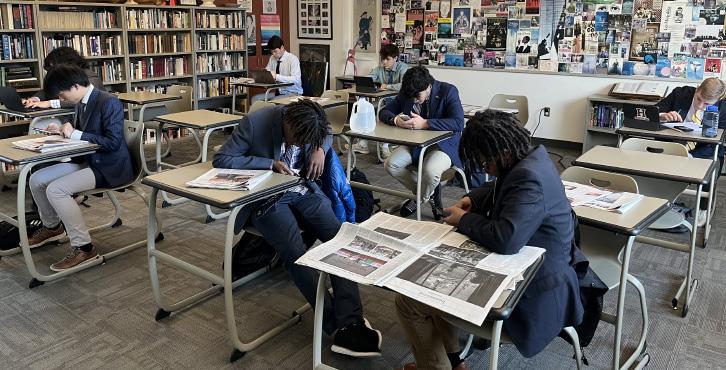
For many Sixth Formers, the majority fail to realize the possibility of free time to replace ASB lies in their own hands.
Mr. Kolade said, “I think that when seniors show that they can do all the things that are expected of them, [ASB not being mandatory] is something that we can consider.”
Students discuss relevance of the Russo-Ukrainian War
Over one year ago, on February 24, 2022, Russian armies ordered by President Vladimir Putin invaded Ukraine, the largest military action since World War II.
Though the conflict did not receive much attention at school in its first weeks, according to many students, the few conversations surrounding the topic have dwindled further.
“It has kind of died down. There hasn’t been as much hype about it,” Third Former Chase Baker said.
As a result, Baker believes he is not well informed.
“At first it was like everyone was talking about it, and it’s still going on, but I feel like if I were to be questioned about it today, I wouldn’t know about it,” Baker said.
Many students think this is a problem, and that such an important event deserves more attention.
“It’s important to talk about modern world events in classes, because it informs us more, which is a good thing,” Third Former Jack Chisholm said.
According to the daily email newsletter Morning Brew, there have been an estimated 300,000 total combat casualties, (100,000 Ukrainian, 200,000 Russian,) and over 7,000 civilian casualties. Nearly 20% of Ukraine’s pre-war population (8,000,000 people) have fled the country, and the country has endured hundreds of billions of dollars of property damage. Though the war has caused many casualties on both sides, many upper school students would support United States involvement.
Third Former Jack Ford said, “I think it would be a good idea for [the United States.] to intervene, I just don’t think it’s going to happen.”
Though many support the idea of inter-
vention, many students do not see this as a likely scenario. Chisholm said, “I don’t think Joe Biden would intervene unless Putin did something really drastic or over the top.”
Still, the students questioned about this topic all believed that they did not have enough information about the war to come to specific conclusions about how or if intervention should be handled.
Many students supported the idea of sending additional weapons and supplies to Ukraine. Western equipment given to Ukraine from the United States, the United Kingdom, and the European Union (led by Poland, Germany, and the Netherlands) thus far has totaled over $55 billion, as estimated by the B.B.C.
“It is a good idea to send arms to Ukraine,” Third Former Ranvir Gill said.
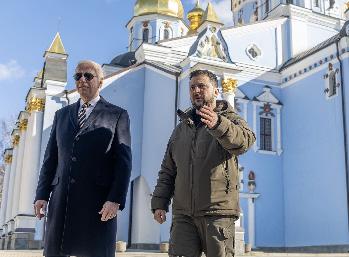
“Without our help, Ukraine would surely fall to the Russians.”

Others believe that sending equipment would not be an effective way of helping Ukraine. Third Former Peter McElhone said, “I think that the U.S. should send people on with the equipment if they’re going to send equipment, otherwise it would be a waste.”
Once more, interviewees did not wish to get into specifics about American aid, as many thought they did not have enough information on hand to provide an educated opinion.
Another issue is the length of war, and the possibility of it extending a lot longer.
“The war will never completely end, it will just die down and become irrelevant in the media unless something very drastic
happens, or will ground to a stand still,” Chisholm said.
The front line now stretches over 600 miles. Because of the front line’s length, The Washington Post claims that it seems unlikely that either side will make worthwhile gains without a huge advantage in military personnel or armaments. What does seem evident, however, is that without the support of the West, it is almost certain that Ukraine will fold to the Russians.
Students think it is vital that the West stands up to Russia.
“It is important, as of now, to hold off the Russians because it protects innocent lives. But if Putin threatens something like nuclear war, then we should stop as it would put too many innocent lives in harm’s way,” Gill said. “We can’t let Ukraine fall to the Russians, because if they did, the West and American hegemony would fail.”
Sixth Form members of the English IV-Journalism seminar during ASB, March 1, 2023
Biden, Ukrainian President Zelensky at Kyiv, February 20, 2023 BILLY BEIFELD ’23 THE WHITE HOUSE VIA WIKIMEDIA COMMONS the index · news March 2023 Page 6
Harrison Cross ’26
The majority fail to realize the possibility of free time to replace ASB lies in their own hands.
features
Café breakfast sandwiches remain flavory

One of my teachers says he does not believe in the mission of The Café. School shouldn’t have a concession stand, he says. He has a point. It’s school, not a movie theater. And I could imagine how The Café might hypothetically distract a student
from, I don’t know, being in class. That being said, students love The Café. We’re hungry, and it has food. So for now, school comes equipped with its own snack bar, stocked with chips, energy drinks, and yes, breakfast sandwiches.
Only now, three months from graduation, have I realized how much I’ve missed out on by rarely going to The Café and almost never indulging in their breakfast sandwiches. Most of The Café’s food is standard concessions fare—sweet and salty nothingness, unfulfilling calories. Pringles manage to be oily and somehow leave you more hungry than before, Nutri-Grain bars feel like a rip off, and gummy bears at 10:00 a.m. feel immoral.
But a toasted English muffin, two slices of soggy egg, melted cheese, something buttery, something warm—warm!—is the perfect mid-morning snack. It’s not quite hot but rather heated, probably warmer than anything else you’ve eaten today, definitely warmer than the early-March air that isn’t even that cold and yet envelops you with a slight shiver as you eat.
The café breakfast sandwich is not eaten; it is scarfed. It is not a meal. It is a food that occupies the liminal space between
blocks of time, between locations, between Centennial and Wilson Hall.
Everyone who buys a sandwich is grateful for having done so; the reason being that eating something of substance before lunch is a battle for every student. There never seems to be enough time before school to make a real breakfast. And a lifetime seems to pass before lunch starts.
So when you get your hands on a warm cylinder of food, real food that doesn’t come in a bag but is rather wrapped in thin, paperish aluminum foil, you are grateful—grateful and salivating. You thank whatever being above has given you this gift, you take a sip of a Sparkling Ice + Caffeine, and down the sandwich in the little time you have.
“You never see a sandwich there at the end of the day,” Sixth Former Julian Caesar said.

It’s true, The Café runs out of sandwiches fast. Sometimes you’ll get there as early as 10:30 a.m., as I did on a recent Wednesday, and find The Café deserted, no people or breakfast sandwiches in sight. You’ll wonder if the only thing The Café truly sells are breakfast sandwiches, and once they’re all out, the masses flee to greener pastures, to hidden stockpiles of advisory snacks deep within the catacombs of Wilson Hall.
and biscuits are also favorites, and the bagel also makes an appearance in the rotation.
“I just wish there was some consistency,” Sixth Former Harvey Pennington said. Pennington lamented the rotation of the bread of the sandwiches; he eats them around once every two weeks.
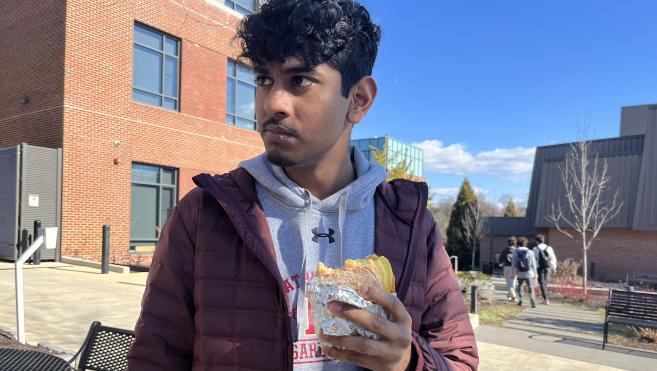
“I think the croissant is the rarest one, like out of all of them,” Caesar said. “It’s like a collectible.”
Whatever bread they use doesn’t really matter. The English muffin was satisfying, with its ridged terrain. But any assortment of bread-iness to surround the egg-iness will result in scrumptiousness, I’m sure.
In the end, it comes down to one thing a Third Former said to me.
“I guess it’s like…flavory,” Third Former Hessikaya Jones Williams said.
His friends laughed at his word-choice as he said this. But “flavory” is a real word, and it’s fitting.
Merriam Webster defines the word as “rich in flavor—used especially of teas.” The breakfast sandwich merits the use of the word “flavory,” for it warms the soul just as an Earl Grey might.
Each sandwich costs $4. An egg and cheese costs the same as a sausage, egg, and cheese. Given that an Egg McMuffin is $4.99 and an Egg Cheese Biscuit is $3.19 at the McDonald’s in Ardmore, the price of a café breakfast sandwich is not ridiculous.
The sandwich bread changes every so often. During my week of observations, the English muffin reigned supreme. Croissant
 Students lined up in The Café on a recent morning
JOEY KAUFFMAN ‘23
Students lined up in The Café on a recent morning
JOEY KAUFFMAN ‘23
the index · features March 2023 Page 7
Joey Kauffman ’23
Sixth Former Arnav Sardesai enjoying a breakfast sandwich from The Café JOEY KAUFFMAN ‘23
“I think the croissant is the rarest one, like out of all of them. It’s like a collectible.”
JULIAN CAESAR ‘23
Do students’ opinions matter?
“Life is not a spectator sport…If you’re going to spend your whole life in the grandstand just watching what goes on, in my opinion you’re wasting your life.”
These are the often-quoted words of barrier-breaking baseball legend and civil rights advocate Jackie Robinson. Luckily, here at Haverford, there is never a shortage of students who seek to be involved, whether it’s in the classroom, on the athletic field, within a club, or in a community service activity. And nowhere is that better reflected than in the campus opinions section of The Index
Opinion pieces are not personal essays or news reports, nor are they reviews or promotions. They are arguments. According to The Washington Post, an opinion piece should deepen an understanding of a topic and help raise ideas or perspectives that might not be heard otherwise. Opinion pieces are one way a community can honor diversity: anyone in the community can share an opinion.
Month after month, students do just that: offer opinions and thoughts on issues they feel strongly about. But what happens to those opinions? Is writing an opinion piece for the paper an exercise in futility, or do the faculty and administration read and consider them? Do student opinion pieces ever incite change in school policy?
Conversations with various school administrators and faculty members confirm that the campus opinion section is a widely consumed part of the school newspaper.

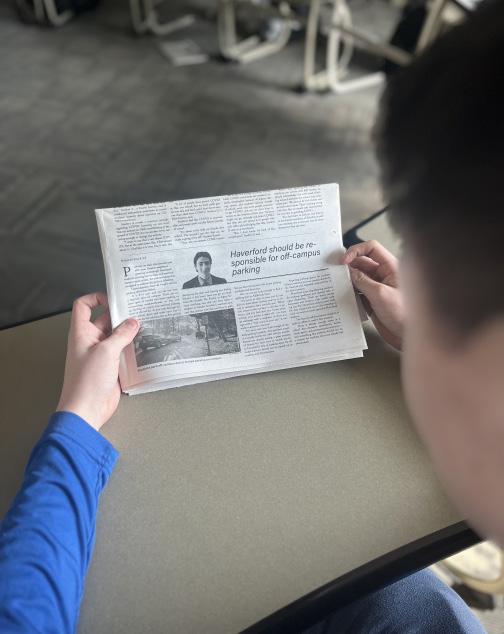
Student opinions matter.
According to Head of School Mr. Tyler Casertano, there is a weekly leadership team meeting attended by all three division heads, Assistant Head of School Mr. Thorburn, Director of DEI Ms. Rhonda Brown, Director of Admissions Mr. Donta Evans, as well as leaders from communications, development, and athletics. During this meeting, the administration will consider and think about what students are sharing. “Change begins as conversation […] and student opinion
pieces are data points in the conversation,” Mr. Casertano said.
Director of Admissions Donta Evans concurs, sharing that he does not view student opinions as complaints, but rather as “data points and opportunities to improve.”
An example of how student opinion can impact school policy is the recently formalized Policy on Academic Accommodations for Reasons of Faith and Conscience. The policy is intended to provide students with flexibility to celebrate days of faith or social conscience that are not already on the school calendar. The policy’s existence is due, in part, to an opinion piece written by Sixth Former Dylan Kao, published in The Index
last April.
Kao wrote an essay for an English class about Lunar New Year and its significance and importance to his family and culture. He shared the essay with the Pan Asian Alliance, which decided it wanted to convince the school to make Lunar New Year a formal school holiday. Kao edited his essay into an opinion piece and published it in the paper. He and other members of the Pan Asian Alliance then met with school leadership.
office door. There is value in being able to formulate an idea, write about it in an articulate and compelling way and then stand by it.
Mr. Casertano said that he hopes students know how much Reflections and, by extension, op-ed pieces mean to him. He wants there to be discussion and even disagreement, but in a way that is conversational, as “the conversations help move disagreement to agreement and then creates a path forward.”
Class of 2022 Ryan Rodack’s piece about parking challenges is a perfect example. Rodack’s piece did not result in the miraculous appearance of fifty more parking spots. But it did offer the administration more context and perspective as they work on long term student parking solutions.
“The school, in its long-range planning, has identified parking as an area of our campus that needs enhancement,” Mr. Casertano said.
Ms. Brown says that while there was already an informal policy in place, Kao’s opinion piece and advocacy helped bring the issue to the forefront. “We don’t want students to ever have to choose between culture and the rigors of being a student at Haverford,” Ms. Brown said.
After meeting with Kao and other members of the Pan Asian Alliance, Ms. Brown began working with the leadership team to develop a more comprehensive policy. While the school did not ultimately make Lunar New Year a formal day off, it does now work with individual students to honor requests to reschedule coursework and/or to be absent from classes for student-identified days of faith or conscience.
“As we get more diverse as a community, there will be more and more requests. We didn’t want to be in the position of saying yes to some holidays and no to others,” Ms. Brown said.
According to Kao, while not exactly what he was advocating for, it felt like a good first step forward, a good compromise.
The compromise underscores an important point about opinion pieces. They are not demand letters. There is a reason they are formally written, edited and published instead of being created by cutting words from old magazines, gluing them onto paper and slipping the paper under Mr. Casertano’s
Of course, not all opinion pieces result in change. Sixth former Joey Kauffman’s September 2022 piece advocating for limits on the amount of summer work for classes failed to sway English Department Chair Mr. Thomas Stambaugh to make any changes to summer reading requirements. “[Students choose] to take the Honors English class and presumably understand the course requirements will have an increased demand on their time.”
According to Kao, writing his opinion piece and publishing it in The Index was worthwhile, “It is a way to get your message to the entire school, administration, and faculty.”
Regardless of how an op-ed piece is received, taking the time to share a perspective, to advocate for a change or argue for an idea is one way to get out of the grandstand and engage with the life of the school. But, then again, that may just be a matter of opinion.
CASEY WILLIAMS ‘24 OWEN YU ‘23
Connor simpkins ’25
“It is a way to get your message to the entire school, administration, and faculty.”
DYLAN KAO ’23
the index · features March 2023 Page 8
Sixth Former Dylan Kao’s campus opinions piece “Lunar New Year should be a school-wide holiday” basks in sunlight as a student reads the section
Student reads Class of 2022 Ryan Rodack’s opinion piece “Haverford should be responsible for off-campus parking”
“We don’t want students to ever have to choose between culture and the rigors of being a student at Haverford.”
MS. KRISTIN BROWN
Students juggle school work... and jobs
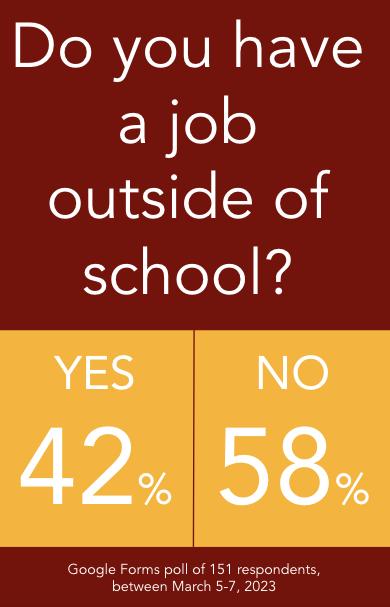
Many students find it hard enough to balance all their school activities, such as homework, clubs, and sports. However, some members of our community find the time to also work jobs on top of all of their school commitments. Many think that working a job in high school could hurt academic performance, but there are numerous benefits as well.
Fourth Former Aaron Bonaparte, a busser at Rosalie in Wayne, has a number of jobs other than just clearing tables. “I’m… collecting plates from tables once they’re finished and refilling stations and helping servers and runners whenever I can,” A. Bonaparte said. “Working has changed my perspective a lot just because I kind of realized the concept of being able to actually buy something versus being able to afford something.
“My idea of bills right now is making sure my Spotify and my Hulu get in on time, but throughout my life those bills are probably gonna multiply. So, my Spotify will eventually become rent, which will eventually become a mortgage so it’s definitely put stuff into perspective for me,” Bonaparte said.

of work that they’re interested in.
Fifth Former Jai Bonaparte works at Pretty Tasty Cupcakes in Conshohocken.
Many would consider these to be important skills and knowledge for a sixteen year old. A steady income allows a teenager to learn to manage their money without the stakes that comes with adult life. Working also allows teenagers to learn about the kind
“[I do] cake decorating, making and scooping cookie dough, decorating cupcakes, you know, fun stuff,” J. Bonaparte said.
Finding a job he liked, however, wasn’t easy. “I hated my other job, and the boss at the bakery is good friends with my mom. And… I can bake and one thing led to another,” J. Bonaparte said.
Fourth Former Zach Dixon, who works at CJ Tires and Auto in Wayne, had similar insight.

“I think that my perspective was always like yeah, people have to work for money [through] different jobs, but I feel like I got lucky in my job because I get to do what I want,” Dixon said.
He also said that he didn’t like his old job, and that working has broadened his perspective on workers in his daily life.
“My old job, my lifeguarding job, I did not like that at all. So that was more of an experience that [opened my eyes] that there’s people that are working at McDonald’s,” Dixon said. “They don’t want to be there. That sucks. I feel bad for them. And it definitely taught me that people will do stuff for money and it’s pretty hard to get by.”
Fifth Former Chase Nelson’s perspec-
tive on the value of money also changed after working at Greek Village retirement home.
Most of the time I would barely get a break even with child labor laws,” Nelson said. “And just when I got that paycheck after the two weeks I looked at it I was like, I really really earned it, and I respect you for how much you make. Maybe less or more than I made, I still think that that’s a whole different level of appreciation.”
Working a job outside of school teaches students things they cannot learn anywhere else. Nelson also said that balancing school and work life was hard, especially during the school year.
“I appreciate any dollar, any cent that I make because it’s just how many hours I put into it. I used to work those eight-hour days.
“[Working during the school year] became very hard because most of the time I would work from either end of school Friday, as well as all weekends,” Nelson said. “Sometimes if I wanted to pick up extra hours, I would work on days that we had school off, and by doing that I just felt so exhausted. I felt like I wasn’t putting enough into certain things. Or sometimes I would feel like I put too much into it. I wasn’t getting a good balance.”
However, some students are able to manage working during the year. Sixth Former Nate Mirin works as an intern for two charitable organizations, Tree-Plenish and Character Lab.
“I just gotta plan out my time a little bit more. Not necessarily work any harder, just have a plan for it. Don’t let anything get in the way of what you’re trying to achieve,” Mirin said. “Otherwise, I make sure to make it work. Maybe I’ve been getting a little bit less sleep. But that’s a trade off I’m willing to make because they’re organizations I care about.”
GOOGLE MAPS
Luke Ganley ’25
ROSALIE
“I appreciate any dollar, any cent that i make because it’s just how many hours I put into it.”
CHASE NELSON ’24
A stead income allows a teenager to learn to manage their money without the stakes that comes with adult life.
the index · features March 2023 Page 9
Rosalie in Wayne, where Aaron Bonaparte ’24 works
Pretty Tasty Cupcakes in Conshohocken, where Jai Bonaparte ’24 works
“I hated my other job, and the boss at the bakery is good friends with my mom. And... I can bake and one thing led to another.”
JAI BONAPARTE ’24
The middle school’s newspaper: Fords Forum
Readers of The Index may be unfamiliar with The Fords Forum, the middle school’s newspaper.

“The Fords Forum? What’s that? The middle school has a newspaper?” Sixth Former Andrew Case said.
when we moved to the trailers and the new middle school was being constructed,” Mr. Newman said. “But the philosophy doesn’t change. It’s always about getting the guys to think about the school community and the world around them.”
At The Fords Forum, middle school journalists are offered many writing opportunities. This helps funnel talents to The Index at the upper school.
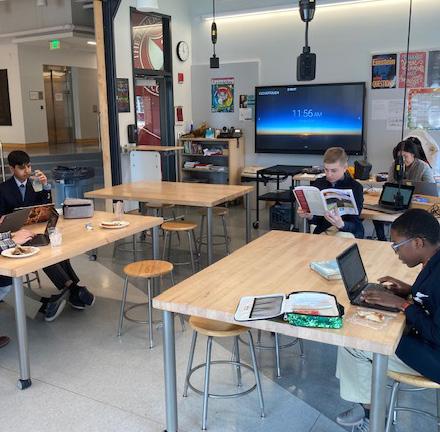
Around the nation, middle schools rarely have their own news publications. At Haverford, a decades-long intellectual tradition and a supportive administration had uniquely nurtured The Fords Forum Since its first appearance around 2019, the student-run publication grew to become an independent platform for the voice of the middle school community.
“The Fords Forum was created only a few years ago,” Middle School Head Dr. Jay Greytok said. “But prior to The Fords Forum, since the inception of the middle school, back in the late fifties, there has been a middle school newspaper called The Crosman Chronicle.”
The Crosman Chronicle rebranded itself
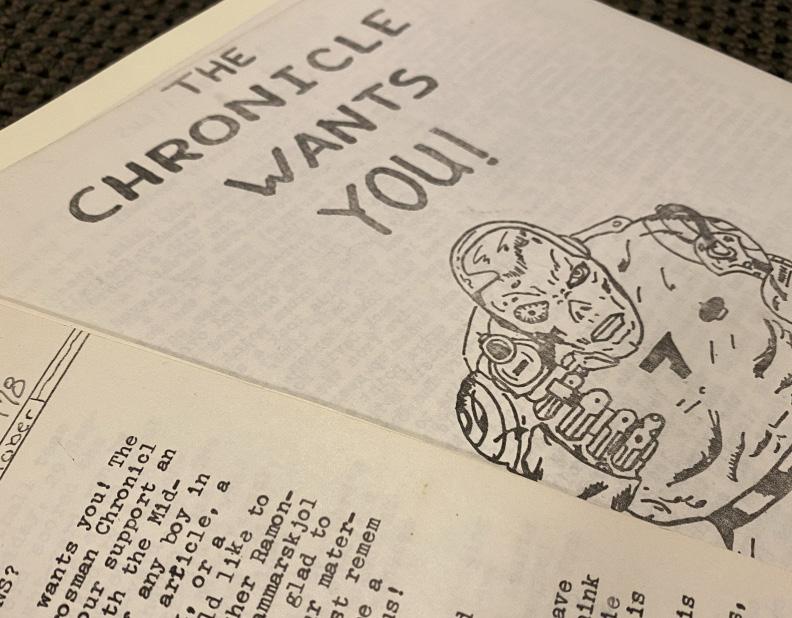
“One of the things that we try to do in middle school is provide a junior upper school experience,” Dr. Greytok said. “So every boy has a chance to try something and maybe find his passion as a future writer for The Index. Here’s an opportunity for them to get involved in a little bit of journalism and what is required in order to put something like this together.”
Mr. Newman thinks the newspaper’s student-oriented leadership structure helps middle school writers develop the ability to work through planning, writing, formatting, and publishing independently.
“Philosophically, The Fords Forum has always been student-directed,” Mr. Newman said. “Mrs. Brown and I are just there as the adults in the room. But really, it’s studentdirected in almost every way. The students generate it. They set deadlines. And they get it published. It’s something that the guys take responsibility for and feel proud of.”
Middle school student leaders share their own stories with The Fords Forum and
“We have certain activities we add in throughout The Fords Forum,” Stern said. “There’re word scrambles, or ‘Guess the Faculty Member.’ We let the kids interact with the newspaper and ask each other questions.”
journalism that we have been doing for The Index. Could we go in that direction? Absolutely. But it’s a student paper, so it’s going to be whatever they want to do,” Dr. Greytok said.
Stern agrees. He notes how the middle school perspective gives The Fords Forum a unique attraction.
“Most other middle schools don’t have their own newspaper. We love to have it because it’s the middle school writing, editing, and reading about middle school. And it’s just different than what you see in other places,” Stern said.
Stern talks about the middle school’s community engagement with the first issue he published in the Fall of 2022.
as The Fords Forum a few years ago when the middle school moved out of Crosman Hall. Current teacher advisors of The Fords Forum are Middle School History teacher Mrs. Kori Brown and Librarian Mr. Josh Newman.
“I just stepped up and got involved this
how they grew to become invested in their tasks.
“I first learned about it from an email in sixth grade. I think they sent it out to the whole school. So I emailed the editor at the time and told him that I would want to get involved,” Second Form Fords Forum editor Keith DiMarino said.
DiMarino has written several major pieces for the newspaper, including an interview with Head of School Mr. Tyler Casertano. Last September, DiMarino assumed the role of an editor with First Former Ethan Stern.
Stern explains the logic behind his decision to introduce interactive sections to The Fords Forum
“We look at The Index. Everyone’s reading that,” Stern said. “But we make ourselves a newspaper for the middle school. Middle schoolers don’t have the same engagement as upper schoolers do. So we do our articles differently for our readers.”
Dr. Greytok has fully endorsed this shift in the newspaper’s style.
“The Fords Forum, first and foremost, encourages the middle school boys to write. It is not necessarily meant to be the type of
“We didn’t really know how it was gonna go because it was the first issue we published,” Stern said. “We printed eighty copies. But when we actually started handing them out, they just disappeared immediately.”
“This year we want to get as many editions as we can, more than just three for three trimesters. That’s what we’re aiming for. We really want to have people say, ‘Did you read this part of The Fords Forum?’ We want people to have healthy arguments and have a good experience.”
year, because there was a vacant spot, and Mrs. Brown asked me if I was interested,” Mr. Newman said. “Being someone who loves the written word, journalism, and responsible consumption of news, I thought it would be a cool thing to do.”
Under teacher mentorship, The Fords Forum seeks to continue the legacy of The Crosman Chronicle and build student interest in writing and journalism.
“We rebranded it The Fords Forum
“Ethan and I have a set meeting time. For a couple of hours, we’ll go together. We’ll talk about what we’re doing today. Today, we’re gonna do a little bit more writing and a little bit more fun stuff,” DiMarino said. “I communicate with the writers to make sure they do their job and turn in their articles. Ethan’s responsibilities lean more toward putting together the paper on Apple Pages.”
In charge of design and formatting, Stern has been adding innovative elements to The Fords Forum to suit the taste of the middle school.
Jingyuan Chen ’23
Advisor Mr. Josh Newman poses with a copy of the fall issue
The Crosman Chronicle, the middle school newspaper, recently renames The Fords Forum
JINGYUAN CHEN ’23
Fords
staff members at work on their next issue JINGYUAN CHEN ‘23
JINGYUAN CHEN ’23
Forum
“The Fords Forum was created only a few years ago”
DR. JAY GREYTOK
“Middle schoolers don’t have the same engagement as upper schoolers do. So we do our articles differently for our readers.”
ETHAN STERN ’28
“It’s always about getting the guys to think about the school community and the world around them.”
the index · features March 2023 Page 10
MR. JOSH NEWMAN
Behind the voice of the Fords: Charlie Keidel
The chaotic student section does not provide the loudest voices you hear during the basketball games. Beyond the student chants, or Coach Rogers drawing up a play, you hear a “THREE
Connor Scanlan,” or a “Introducing your Haverford School Fords!”

At every basketball game held in McBride Court, and soon, every baseball game on Memorial Field, fans hear Fifth Former
Charlie Keidel showcasing his skills as the announcer for the Fords.
Students and fans often overlook what the announcer does for the team and the game’s environment. As an announcer, Charlie Keidel holds his own and performs well behind the mic.
“This is his first year announcing, he works hard at it, it’s not the easiest thing. You have to be confident, willing to be loud to hype up the crowd, and he has been improving every single time he goes out and does it and it has been really cool to see for me,” former student announcer Luke Kania ’19 said.
It is remarkable that Keidel was able to pick it up so fast. Announcing is not a popular job at the school; it is even more impressive that he was willing to step up for the program. There are not any “announcing tryouts.” Typically when a manager is willing to announce, he will be given the opportunity.

“I talked to Luke Kania. He told me it would be a positive thing to do and thought I would be good to take over his position,” Keidel said. “I wanted to immerse myself more and to be a part of a team that I would not be able to make athletically.”
“Being a part of the team” is not just announcing for the games, Keidel’s work ethic goes beyond the games, just like any other player.
“He, along with [Fourth Former] Jay Rogers, are just as much a part of the program as anyone else,” Assistant Basketball Coach Mr. Jeremy Hart said. “Charlie can always be counted on for bringing good energy and instigating what is good for the team.”
“[Keidel] just brings a good energy to
practice every day. He’s always got a smile on his face, and he always does the little things that not everyone wants to do,” Kania said.
Even though he is not a player, the team feels as if he belongs there.
Sixth Form varsity basketball player Brendan Leary said, “He brings great energy, he’s always fun to talk to on the sideline. Charlie has his unique ways of getting involved, he either tries to hop in a drill or asks us for songs to play to pursue our interests.”
Energy is certainly a common trait the team notices about Keidel. He has to be unique in order to keep the job. Being the voice of the Fords is being a part of something bigger than yourself.
Mr. Hart said, “I do think his announcing is a great way of continuing the tradition started by Luke Kania, and there will be a great battle of playing time between him and Jay Rogers as the voice of the Fords.”
The 2022-23 Index Staff
Cole Donnelly ’23
Official School Portrait of Charlie Kiedel
the index · features March 2023 Page 11
COURTESY OF CHARLIE KIEDEL
“[Keidel] just brings a good energy to practice every day. He’s always got a smile on his face, and he always does the little things that not everyone wants to do.”
LUKE KANIA ’19
academics

Should we include more current events in our classroom?

Current events are everywhere: headlines are available in an instant, clickbait permeates social media and internet sites, and talking heads deliver (often biased) news to their viewers daily. But for many, exposure to current events stops there. Among a sampling of Haverford upper school faculty members polled, just 30.4% reported that they discuss current events frequently in their classes.
Students also note the general absence of current events from their classes.
or not, or omit important parts of topics and events to fit their own viewpoint.”
Even from reliable sources, headlines, 30-second TikToks, and even news articles might not expose readers to all facts and all sides of a story.
Media cycles often focus on a select few events, and not all events surpass the “threshold of excitability,” a term that Modern and Classical Languages Department Chair and Global Studies Coordinator Mr. Andrew Poolman uses in his Global Perspectives elective. The term, which Mr. Poolman teaches through the essay “An Attainable Global Perspective” by Robert Hanvey, refers to what interests consumers in their news. That which rises above the threshold—daily headlines, topics discussed ad nauseam on talk shows, etc.—does not always represent the events occurring around the world, nor does it fairly or accurately portray certain groups.
“Current events barely come up [in class] unless I’m in US History or it’s sportsrelated and someone just randomly brings it up,” Fifth Former David Stewart said. “Most of my news comes from me hearing other people talk about it or YouTube.”
According to the Pew Research Center, almost half of Americans get news from social media “often” or “sometimes.”

“When you look at current events on TikTok or Instagram, you’re getting 30-second snippets [of stories],” history teacher Mr. Jeremy Hart said.

But it’s not just length that causes reliability issues. Major media networks are often biased and bring one-sided views to issues. Fox News and MSNBC—which are frequently considered right-wing and leftwing media networks, respectively, receive the majority of American cable news viewership numbers.
Mr. Hart believes that student media exposure is influenced by sources. “If you’re watching Fox News or CNN, you’re getting, in my opinion, slanted points of view, and I think it’s really important today for students to know where the source is coming from.”
Students are concerned about media bias as well. Fourth Former Gabriel Crowder said, “Almost all news I come into contact with is biased. Finding a source that provides only facts and analysis is difficult, especially on controversial topics. In addition, anyone can post information regardless of if it is true
For example, Mr. Poolman, also a Spanish teacher, said, “Often, in Latin America, what rises above that Threshold of Excitability are things like gangs and [narcotics] trafficking and immigration, or problems within a government, so those are the common Latin American news stories, but in Spanish classes, we try to go beyond that and show that there’s much more to Latin America than those topics.”
Because of media bias, the prevalence of dis- and misinformation on the internet, and the omission of some information, media literacy, the ability to critically analyze stories presented in the mass media and to determine their accuracy or credibility is at a low. The News Literacy Project, an independent nonprofit, reported in 2022 that over 55% of American students were “not even moderately confident in their ability to recognize false information online.”
History teacher Mr. Kevin Tryon, who uses current events to begin conversations at the start of every class, said, “[Sourcing] is probably the most important thing, in some ways, that the History Department can do. The most important questions are ‘Who is
the author’ and ‘What authority does he or she have?’”
However, he believes teaching media sourcing is more effective through research papers and annotated bibliographies than through current events-based exercises.
Although Mr. Tryon believes that research papers and annotated bibliographies teach a lesson about sourcing more effectively than current events, he acknowledges that modern media can give rise to misinformation issues. He has even noticed, questioned, and discussed misinformation that arose in his own classroom current events warmups. Yet, Mr. Tryon finds positives in digital media. He said, “As a sophomore, I didn’t follow the news. [...] I would give the boys credit for being more aware of the news now than I was when I was growing up with print media.”
Discussing media literacy, Head of Information Services Ms. Lisa Snyder said, “Our news consumption has become individualized. Folks no longer have a common
source for what’s happening in the world and why. And that can lead us to lose our common understanding of shared facts and history. To compound this, most of us get news from social media, which uses algorithms to
anticipate what you’ll be interested in. These sites are designed to give you content that confirms your beliefs and biases.”
Ian Rosenzweig ’25
Ryan Getz ’23 gets most of his news through Twitter
the index · academics March 2023 Page 12
IAN ROSENZWEIG ‘23
VIA WIKIMEDIA COMMONS
Rally in support of Ukraine in Times Square following the Russian invasion of Ukraine, February 26, 2022
“Current events barely come up [in class] unless I’m in US History or it’s sportsrelated and someone just randomly brings it up.”
DAVID STEWART ‘24
The New York Times building in New York, NY across from the Port Authority
VIA WIKIMEDIA COMMONS
“And that can lead us to lose our common understanding of shared facts and history”
MS. LISA SNYDER
“Our news consumption has become individualized. Folks no longer have a common source for what’s happening in the world and why. ”
MS. LISA SNYDER
Should we include more current events, cont.
To supply reliable media, Severinghaus Library provides all students with a free New York Times subscription, but Ms. Snyder’s concerns raise a vital question: in addition to providing sources and educating students about reliability, should institutions like Haverford dedicate time to providing educational content on current events that may not be accessible through the media?
Teachers in various departments concur that educating about current events— whether for the actual content, the media literacy skills, or the lessons connecting to the world—is directly linked to various aspects of Haverford’s mission.
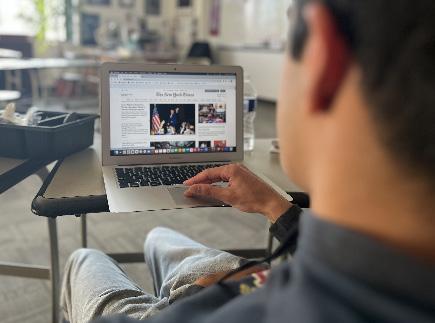
Chemistry teacher Mr. Will Leech connects education about current events to global citizenship.
ting from discussing current events,” he said.
Mr. Hart, also connecting current events education to Haverford’s mission, believes that understanding current events is a vital part of Haverford’s promise to “prepare boys for life.”
“One of the key targets of the school is that we create global citizens,” he said. “Having conversations about real-world events is how I create global citizens in my class who are thinking from a variety of different perspectives.”
Similarly, Mr. Poolman noted that understanding “global dynamics”—which current events education can provide—is a crucial aspect of global citizenship.
Although connections to current events may be less apparent in content-driven science classes, Mr. Leech has found ways to incorporate events in ways that both align with his curriculum and stimulate broader discussions.
“This goes beyond subject knowledge, and it goes into more the skills, the application, and the transferability that we’re get-
“Having the critical thinking skills and the content base [to discuss current events] is part of what prepares boys for life,” Mr. Hart said. “It’s important to be able to have an informed discussion and figure out where you stand. That’s part of being an adult.”
Academically, some teachers find various ways to apply current events to their classes, but students also feel that direct learning about current events could be beneficial, especially when many media sources today are biased.
Stewart said, “I really hate when any news station has someone talking about their opinions because I’m there for the facts, so I prefer educational news.”
Fourth Former Elliot Lee agreed.
“I think school should talk about current events more frequently, as they are important to understanding our modern world today. After students graduate, they need to be able to function in society—part of that
is understanding events in the world of politics, environment, economy, and more,” Lee said.
Teachers have also noticed students’ interest. In a recent lesson on the rise of the Soviet Union, Mr. Hart connected the Holodomor—the Ukrainian Great Famine— with the contemporary Russian invasion of Ukraine.
“Often, I like to deal in facts. And I could share the facts about the chemical spill and the reactions that were happening, but then it went into the realm of ‘well, who do you think is responsible’ and then that becomes a little more of a gray area, and it’s really interesting to see my students in those sorts of environments, having conversations that would be more comparable to something in a history or English classroom,” Mr. Leech said. “It was really exciting for me. I love leading those conversations.”
Such discussions may be more prevalent in humanities classrooms, but, as Mr. Leech said, there is also space and relevance for current events in science classes and even an opportunity for interdisciplinary learning.
“I find that students are more engaged when discussing current events because they’re hearing things that are tangibly applicable to their lives,” Mr. Hart said.
Mr. Leech also found strong engagement when he taught a lesson about the recent train derailment and subsequent chemical spill in East Palestine, Ohio. He also enjoyed introducing a new, relevant lesson into his normal chemistry curriculum.

“If I were to make one improvement to the discussion I had with my students about the Ohio train disaster is that I would’ve loved to have gotten one of my history or English colleagues to discuss what’s going on with it in terms of the sources of the information, or the role of the media. I would’ve loved a bit of cross-curricular work between the subjects on the topic to have a conversation,” Mr. Leech said.
Across disciplines, current events have found a place in the curriculum and even align with Haverford’s mission and motto, but there is room for more. With misinformation and bias on the rise and media literacy on the decline, current events can be taught in educational settings to provide a short-term solution to a universal problem, and current events can also be used to remedy the media illiteracy facing the youth population.
“Current events are life. And they’re things that we’re all going to have to grapple with,” Mr. Hart said. “Having the space to explore those ideas [in upper school] opens you up to more ideas in the future.”
VIA WIKIMEDIA COMMONS the index · academics March 2023 Page 13
Norfolk Southern contractors removing a burned tank car from the crash site in East Palestine, Ohio
“One of the key targets of the school is that we create global citizens. Having conversations about real-world events is how I create global citizens in my class who are thinking from a variety of different perspectives.”
MR. WILL LEECH
“Having the critical thinking skills and the content [to discuss current events] is part of what prepares boys for life.”
MR. JEREMY HART
“After students graduate, they need to be able to function in society–part of that is understanding events in the world of politics, environment, economy, and more.”
COLIN STEWART ’22
CASEY
Student scrolls through The New York Times
WILLIAMS ‘24
“I find that students are more engaged when discussing current events because they’re hearing things that are tangibly applicable to their lives.”
MR. JEREMY HART
“Current events are life. And they’re things that we’re all going to have to grapple with. Having the space to explore those ideas [in upper school] opens you up to more ideas in the future.”
MR. JEREMY HART
FORDS @ SCHOLASTIC ART & WRITING

Journalism pieces by The Index writers that received recognition in the annual Philadelphia Region Scholastic Writing Contest.
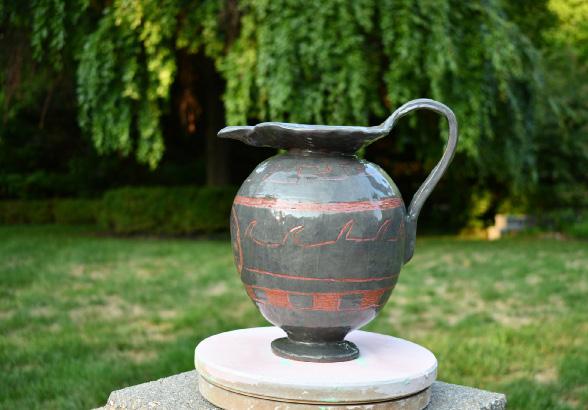
• Adiyan Nayak ’24, “Students and faculty debate Musk’s Twitter acquisition”
• Christopher Schwarting ’24, “Queen Elizabeth leaves a lasting legacy, but Gen Z must be sure to see it all”
• Connor Simpkins ’24, “James Webb Space Telescope poised to change our understanding of space”
• Connor Simpkins ’24, “Students reflect on the two-year anniversary of COVID”

• Ethan Chan ’23, “Donda: A spiritual awakening”
• Ian Rosenzweig ’25, “Department chairs weigh perceived STEM-humanities divide”

• Ian Rosenzweig ’25, “Oxford High School shooting unnerves a nation”

• Ian Rosenzweig ’25, “The 2022 World Cup in Qatar is an opportunity to unite around human rights”
• Casey Williams ’24, “Community reacts to Kanye West’s antisemitic remarks”
the index · arts March 2023 Page 14
3-D art pieces, sculptures, photographs by upper school students that received recognitions in the annual Philadelphia Region Scholastic Art Contest.
COURTESY OF ETHAN LEE ’24 COURTESY OF ETHAN LEE ’24 COURTESY OF ETHAN LEE ’24 COURTESY OF ETHAN LEE ’24 COURTESY OF ETHAN LEE ’24
Boathouse Typography
Map
Walnut and Maple Tensegrity Table
Oinochoe Inspired Terracotta Pot
A Rare Find
Light Breakfast
answered every question compassionately and with an obvious command of the long history of policing and civilian protests in the United States.”
After the lecture, students had the opportunity to ask Dr. Hinton questions in a smaller question-and-answer setting.
“The boys who engaged with the lecture and Q&A with their full attention and curiosity got a ton out of it. The daughter of former Head of School Davis R. Parker [after whom the lecture is named] attended the evening lecture and was moved to tears and thought it was one of the best she had ever attended,” Ms. Turlish said.
Successful Parker Lecture impacts student body

The Parker Lecture is a distinguished tradition each year. This year, students and faculty had the opportunity to listen to Dr. Elizabeth Hinton, a historian and professor of History and African American Studies at Yale University. Dr. Hinton’s February lecture concerned police brutality and reform, and it included controversial notions regarding rioting in the United States.
The lecture was organized by the Chair of the History Department Ms. Hannah Turlish, who has coordinated the Parker Lecture for the past nine years.
“I work from a short list of U.S. historians who are leaders in their field, famous, as it were. One of my top goals is to have scholars who are doing important, groundbreaking work, or at least to try to get such people,” Ms. Turlish said.
“Dr. Hinton’s book America on Fire was frequently cited as one of the most important history books of 2021,” Ms. Turlish said, “so that put her on my radar, along with similarly celebrated academics.”
Then, the communication begins.
“I then need to contact the historians, which often then means working with literary agents or doctoral students who assist them, and then we talk about money and scheduling,” said Ms. Turlish. “This all takes many weeks, and often months, of planning and negotiation, and it usually needs to get done by the end of the summer, given how packed an in-demand historian’s schedule is.”
Ms. Turlish was pleased by this year’s lecture.
“I thought it was amazing. Dr. Hinton is an incredible lecturer and teacher who interacted in deep and meaningful ways with so many members of our community. She
The student body’s perspective of the lecture shares Ms. Turlish’s enthusiasm.
“The Parker Lecture was the most meaningful time I have spent in Centennial Hall. I believe that the message about the Black experience and the view that other people have of us is rather interesting. I also enjoyed the way that [Dr. Hinton] spoke on these topics because it opened the door for not only black people to do something about the issues but also anyone who has a strong enough conviction to,” Third Former Gianni Word said.
However, Word expressed his annoyance with the ignorance displayed by the audience. “During the presentation, I did notice that not everyone genuinely cared, and the ignorance that people have of the topic not only leaves me with some sort of frustration but also the need to help teach them and
enrich myself. I have previous knowledge and understanding of the topics mentioned, but I do like the narrative of calling the riots what they are, which are protests,” Word said.
If you ask upperclassmen about their experience with Modern World History, they are sure to bring up their time spent during the World War I trials.
what I knew to judge and contribute to the class,” Bongiovanni said. Bongiovanni thinks highly of the project.
“This was certainly my favorite project I have completed during my time at Haverford. Notably, it established an engaging
Fourth Former Kellen Gardner, a student who recently completed his trial, said his favorite part was “competing against classmates in a nontraditional fashion.” He also said, “I learned more because it was a challenge, and I wanted to beat my friends.” The project is made possible by the upperclassmen that fill in as judges during their free periods. Upperclass involvement is an important part of the process, as they have experienced this project in years prior, and they have insight on questions to ask and things to look for.
Fifth Former Quin Bongiovanni was a judge this year.
“The World War I trial was my favorite project I’ve done at Haverford thus far. I genuinely enjoyed it, and I wanted to use
class environment with a healthy competition level which is something that I know my entire class enjoyed. The thorough research we had to do also has prepared me for my future projects, such as my term paper in United States History*,” Bongiovanni said.
Modern World History teacher Mr. Jeremy Hart said having upper-form judges is
significant.
“It raises the stakes [of the trial] because you don’t want to look silly or uninformed around peers that you may be on teams with
Sixth Former Ryan Davey also found the information shared in the lecture staggering. “I liked the lecture a lot; it was extremely eye-opening, and while I have learned about racism before, this year’s Parker Lecture showed it to me in a different and much more personal light.”

Davey also shared his experience at the evening lecture.
“I went to the evening lecture where [Dr. Hinton] talked about a public dance that had been smoke-bombed by the cops, and she talked about the first-hand accounts of some of the people there,” Davey said. “Hearing about what the people had to say made it feel much more real; racism and police brutality weren’t just something on the news anymore.”
Davey shared only one small concern about the format of the lecture.
“The only thing I did not like about the lecture was the format it was delivered in,” Davey said. “I felt that the lecture would have benefited a lot from some pauses to break it up and let the audience know what was coming next. The lecture went from one topic to another very abruptly, so it was difficult to follow, however, that is kind of the nature of a lecture, so I guess I can’t really fault it for that.”
or be friends with,” Mr. Hart said. “It also allows upperclassmen to have opportunities at leadership which allow for a special type of learning.”
Upper-form judges essential to WWI trials
Finn Tierney ’25
Talan Maury ‘26
Dr. Elizabeth Hinton gives the Parker Lecture to the upper school, February 2, 2023 COMMUNICATIONS
McKai Hoillet ’25 gives his WWI presentation in Mr. Jeremy Hart’s Modern World History class
COMMUNICATIONS
“The Parker Lecture was the most meaningful time I have spent in Centennial Hall. I believe that the message about the Black experience and the view that other people have of us is rather interesting. ”
GIANNI WORD ’26
“The World War I trial was my favorite project I’ve done at Haverford thus far. I genuinely enjoyed it, and I wanted to use what I knew to judge and contribute to the class.”
the index · acaademics March 2023 Page 15
QUIN BONGIOVANNI ’24
“Hearing about what the people had to say made it feel much more real; racism and police brutality weren’t just something on the news anymore.”
RYAN DAVEY ’23
“I learned more because it was a challenge.”
KELLEN GARDNER ’25
Model UN builds diplomatic skills and finds success
This summer, world leaders from across the globe will meet in India at a summit known as the G20 to discuss the climate change crisis and many other topics. The G20 and the United Nations share similar goals regarding the cooperation between international organizations and countries to achieve shared goals. The G20 focuses primarily on “international economic development,” and the UN is committed to “maintaining international peace and security.”
The United Nations focuses on bringing together countries that often support different policies to promote international cooperation, social progress, and better standards for human rights. These objectives—and the diplomatic skills they require—are essential, especially for high school students, which is one of the main reasons Model United Nations came to be.
Model UN teaches students tools such as diplomacy, collaboration, and teamwork. It also educates a younger audience about the UN. It is an opportunity for students to work on their public speaking, resolution, and argumentation skills which they may apply later in life.
Haverford’s Model UN team just put their skills to the test at the Ivy League Model United Nations Conference (ILMUNC) at the University of Pennsylvania along with 2000 other student delegates. Haverford delegates had the opportunity to connect with students from completely different areas and sometimes countries, as well as get hands-on experience with simulated UN delegations. Fifth Formers Luke Fesnak and Ethan Lee were honored with verbal commendations, adding their names to the long list of Haverford students who have won awards.
Haverford Model UN has had a long and successful history.
History teacher and Model UN Faculty Advisor Mr. Kevin Tryon said, “I’ve helped with Model UN since 2013, either assisting or leading the group.”
Mr. Tryon also mentioned the many teachers who had led the club before him, including Mr. Evan Wilson, Mr. Rory Hart,
and more.
According to Mr. Tryon, the skills Model UN develops include “public speaking, the evident skill of writing a coherent, concise, position paper, and [the] intangible skill of assessing a room and figuring out how to work it, to get your position to basically convince others about the clarity and authority of your position.”
These skills are the reason so many students from around the world participate in Model UN. Conferences also keep delegates “quite abreast about what is happening in the world, more so than any curriculum,” Mr. Tryon said.
Learning more about the state of the world and the way decisions are made are essential tools for high school students, and Model UN provides the perfect way to learn them.
Fifth Former Luke Fesnak started Model UN early in sophomore year and got into it “because [he] was looking for something to do.”
“I liked it a lot more than I thought. I thought the workload for Model UN was perfect, it was pretty localized in time before conferences.”
Fesnak said, “I liked it a lot more than I thought. I thought the workload for Model UN was perfect, it was pretty localized in time before conferences.”
A common misconception is that academic clubs such as Model UN are major time commitments where students devote hours of time to succeed, but Model UN can be a manageable and flexible club that looks to teach students skills and get them experience, not overload them with work.
Fesnak also mentioned that Model UN
is a great social experience.
“The social aspect of it was really fun. I met a lot of people, I made a lot of strong relations with upperclassmen which I never expected, and that’s why I stuck with it,” Fesnak said.
The relationships that students form through Model UN often last a lifetime and bring the Forms closer together.
“What I love is that we have dinner together, we hang out, and even in internal conferences, we support each other because we know each other, we can laugh, and address serious topics while also being appropriate and having a lot of fun.”
Fesnak added that, from doing Model UN, he learned “how to be friendly without seeming fake [and] how to be polite to people who you don’t know,” which are some of his most valued takeaways.
Genuine friendships and interests can be hard to generate at times, but the most important skill a person can learn is how to be true to one’s self and to operate with honesty.
Fesnak added that the reason Haverford’s Model UN club is so effective is because of its leadership.
“I think we have people who are really supportive at conferences and really friendly. What I love is that we have dinner together, we hang out, and even in internal conferences (FordsMUN), we support each other because we know each other, we can laugh, and address serious topics while also being appropriate and having a lot of fun,” Fesnak
said.
The current Haverford Model UN team captain, Sixth Former Isaiah Schuchman, is a figure many members of the team look up to and come to for advice. Shuchman said that he got involved with Model UN because he “liked public speaking” and “[has] an interest in international relations and debate.” Shuchman said, “I did Model UN in middle school, and I enjoyed the conversations and topics we covered.”
Model UN is a club that picks up students of a variety of ages, and you will often find Third through Sixth Formers participating in the same committee.
“I really got thrown into the deep end and went to ILMUNC. I was one of the only juniors on that trip, so I ended up being head delegate, so I kind of got forced into a new leadership role that way, and I ended up winning my committee.”
Shuchman said, “In freshman and sophomore year, I actually didn’t attend a conference, because of COVID, and in junior year I really got thrown into the deep end and went to ILMUNC. I was one of the only juniors on that trip, so I ended up being head delegate, so I kind of got forced into a new leadership role that way, and I ended up winning my committee.”
Picking something up after being shut off from it for two years is no easy feat, but Shuchman shows that with hard work, anything can be accomplished.
 milan varma ’25
milan varma ’25
the index · academics March 2023 Page 16 COURTESY OF MR. KEVIN TRYON
for
yearbook photo
The Model United Nations Club gathers
its
LUKE FESNAK ’24
LUKE FESNAK ’24
ISAIAH SHUCHMAN ’23
The school should coordinate curricula with nearby schools
IFor being less than two miles away from each other, one might believe that these two high schools would have more connections than they really do, which, as of now, is near zero.
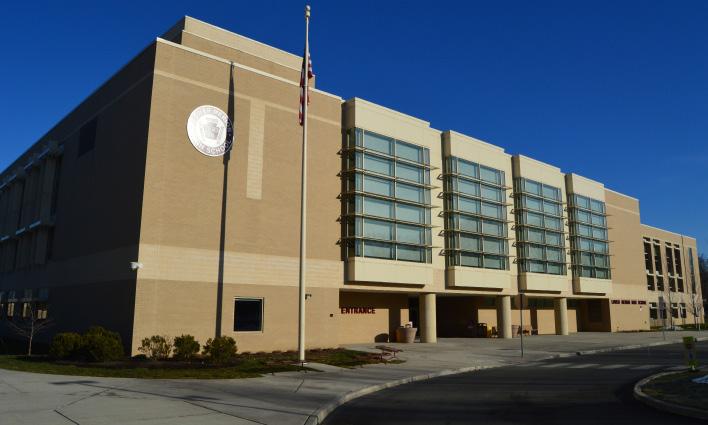
“I know, like, one person from Haverford,” a student from Lower Merion High School said, with his friend chiming in that he knows zero.
“I only met friends from LM through a summer camp unrelated from the schools… and I don’t have any connection with them through any school activities,” a student
in order for this proposal to come to life; already, there are major differences in curriculum, like how while tenth grade Lower Merion students are reading American titles and learning about the American Dream in English, tenth grade Haverford students are focusing on more foreign literature from
sophomore year to teach you guys books that are not necessarily written by Americans.”
Combining curriculums would mean redistributing books all over, making sure they fit the reading level of the grade and the theme of the other books taught that year. In addition, planning it out with not only Haverford teachers but also Lower Merion teachers would be quite the challenge.
“It would be tough. I think the only way to do that would be to have only one person decide the plan and lay it out ahead of time,” Ms. Smith-Kan said.
kids that are reading a similar thing, and you could do projects and stuff like that,” Ms. Smith-Kan said.
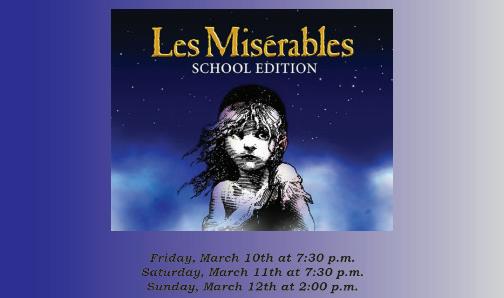
Along with that, while English teachers enjoy picking out a theme and novels that align with their theme for each year, it’s not exactly necessary—and changes in books happen all the time.
“To me, as an English teacher, it doesn’t really matter what [book] you’re teaching because you can sort of talk about anything… if it’s a good book. We switch books all the time at Haverford,” Ms. Smith-Kan said.
from Haverford said.
So far, the current relationship that Haverford has with nearby high schools— namely Lower Merion—is extremely limited; yet, it seems like some might be interested in the collaboration of the two schools.
“I think that interactions with different communities can only be good for this school,” a Haverford student said.
But despite the positive feedback from the idea, much would be needed to be done
around the globe.
“We’ve tried to divide up the years based on what we think would be helpful for the particular grade level,” English teacher Ms. Taylor Smith-Kan said. “We make an effort
Perhaps most importantly though, is losing the benefits of being a private school when having to collaborate with a public school.
“The nice thing about private schools is that teachers have a lot of autonomy, whereas in public schools they are dictated by the state,” Ms. Smith-Kan said. “It kind of defeats the purpose of a private school.”
But, of course, two curriculums do not have to be perfectly synced to allow collaboration.
“If you’re only aligning the texts, then that’s a great idea because you have a lot of
So, while somewhat difficult, the proposal is somewhat feasible and an exciting possibility for some students, but maybe not for everyone.
“I think a lot of people wouldn’t like it, because it’s like, ‘Why are you making me interact with other people outside of my friend group? I’m cool with the friends I’m with’” a Haverford student said. “In the grand scheme of things I believe it’d be for the better, though.”
the index · academics March 2023 Page 17
Kai Degenhardt ’25
“The nice thing about private schools is that teachers have a lot of autonomy, wheras in public schools they are dicated by the state.”
MS. TAYLOR SMITH-KAN
“We’ve tried to divide up the years based on what we think would be helpful for the particular grade level.”
MS.
TAYLOR SMITH-KAN
Lower Merion High School
MONTCO PLANNING VIA WIKIMEDIA COMMONS
“We make an effort sophomore year to teach you guys books that are not necessarily written by Americans.”
MS. TAYLOR SMITH-KAN
Local colleges spur student interest
The jump from high school to college is a massive one—but not one that should separate these sections of the education system entirely. Both of these institutions, the school and the college, interact more often than many know and have a lot to learn from each other.
The Haverford School in particular has the opportunity to bridge college and high school together in many ways due to the location of nearby colleges.
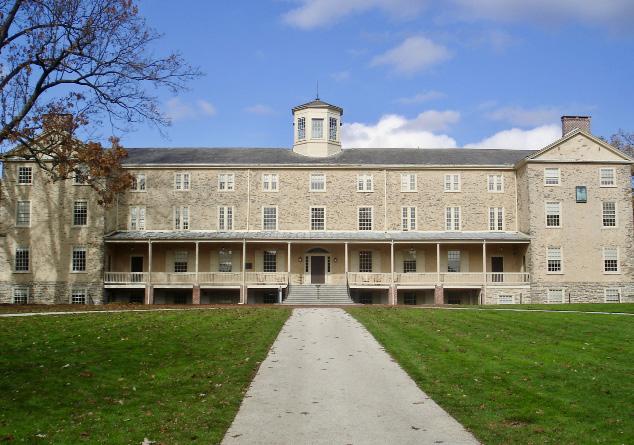
The Haverford School in particular has the opportunity to bring college and high school together in many ways due to the location of nearby colleges. This includes Bryn Mawr College, Haverford College, and Swarthmore, to name a few. This combination of schools is also known as the Tri-college Consortium or TriCo. These colleges share an exchange program. Just as we have our Inter-Ac league, which get schools together for events, colleges in the area and around the world operate in a similar manner.
Casper Hoffman is a sophomore at Haverford College. Like many other students, Casper passes by The Haverford School “whenever I am going to Bryn Mawr College or to the Haverford Septa Station. Since I pass by Bryn Mawr College almost every day, I pass by The Haverford School
quite frequently,” Hoffman said.
Even though this connection may seem insignificant, the fact that college and high school students alike visit the same places and pass by each other daily connects us, a fact not apparent to many. He has firsthand experience with the TriCo collaboration.
“There is a lot of collaboration between the colleges in the area, particularly between Bryn Mawr College, Haverford College, and Swathmore. We can take classes at any of the three colleges and eat at any of the dining halls.”
CASPER HOFFMAN
“There is a lot of collaboration between the colleges in the area, particularly between Bryn Mawr College, Haverford College, and Swarthmore,” Hoffman said. “We can take classes at any of the three colleges and eat at any of the dining halls.”
Hoffman expands on the connection between these schools:
“The social scene is also very interconnected between the colleges (especially between Haverford and Bryn Mawr, since we are so close to each other). There are also inter-college clubs. For example, I am in
Looney Tunes A Cappella, a Bryn MawrHaverford BiCo A Cappella group. Collaboration between colleges is easy because there are buses that regularly run between the campuses that are free for students of the TriCo.”
The fact that these schools run buses between each other further demonstrates how connected they are and how interconnected the Haverford community really is. College students also have a lot to teach high schoolers through their past experiences and the lessons they learned in their time at high school.
“At all three TriCo colleges, you don’t have to declare a major until the spring of your Sophomore year, so it’s great to go into college with an open mind and explore new interests.”
CASPER HOFFMAN
Hoffman says that his “biggest message for high school students is that you don’t have to know what you want to major in before going to college. At all three TriCo colleges, you don’t have to declare a major until the spring of your Sophomore year, so it’s great to go into college with an open mind and explore new interests.”
High school students can even teach
college students about things such as responsibility, spark new interests, and allow them to reminisce on their high school days. Responsibility may seem like something people learn with age, and while this is often true, college students can sometimes use the help due to their high stress levels and workload at that stage of life.
We can utilize what we learned in [Health and PE] to connect to college students on the topic of mental health due to the high stress we all share in attending high-level schools and to possible give them outlets to share our experiences.
Coming from a high schooler, it may seem patronizing, but not all college students had the opportunity to take the Health and PE course we took. We can utilize what we learned in this course to connect to college students on the topic of mental health due to the high stress we all share in attending high-level schools and to possibly give them outlets to share our experiences.
The Quaker Consortium or TriCo is an amazing set of colleges with students who have more in common with us high schoolers than we think.
VIA WIKIMEDIA COMMONS
Founders’ Hall, at the center of Haverford College’s campus
neighborhood the index · neighborhood March 2023 Page 18
milan varma ’25
Students are required to juggle their academic, artistic, and athletic commitments with a remarkable degree of grit, determination, and effort. Countless hours are spent each night completing homework assignments, perfecting projects, and studying for scheduled assessments. This does not take into consideration the hours also spent on extracurricular sports, musical, and volunteer endeavors.
For a large majority of students, this life is lived in pursuit of one thing—to be a well-rounded student with stellar grades on a transcript. Students expend great effort, vigilance, and planning with the expectation that their academic goals will be achieved.
And yet there is one thing that can be a hindrance to their success. Pop quizzes. With sometimes-high point values, pop quizzes can be the nightmare of a diligent and busy student. Without the benefit of notice and preparation, even top students may find themselves disappointed with their grades on a pop quiz, as the grade one worked so hard to achieve can be erased with one unexpected assessment.
Why are these surprise attacks administered? What do the results of a pop quiz really prove? Not all that much. Not only can pop quizzes negatively impact students’ grades, but they also remove one of the main reasons for taking scheduled assessments—
opinions
A case against pop quizzes
to train students to understand the material, stay organized, and practice time-management skills.
The guesswork and anticipation of a pop quiz force students to cram in knowledge at an unnatural pace, and take away from efforts at something with an planned deadline.
Sixth Former Isaiah Shuchman raises other noteworthy concerns.
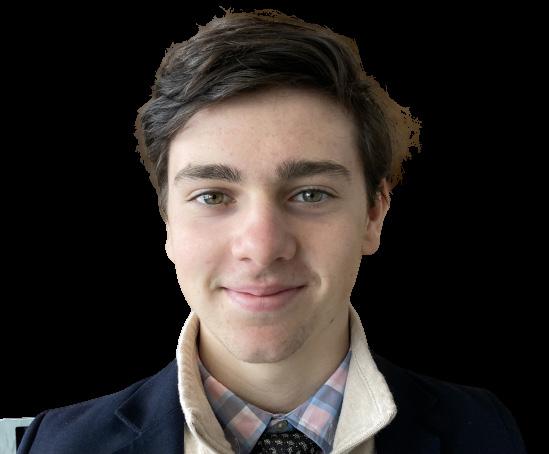

“I think you run into an equity issue when some students know there will be a pop quiz and some don’t, depending on the time of day their class takes place,” Shuchman said. “One class is always disadvantaged. Also, I think students should be trusted to do their readings and homework assignments. If they do, it will be reflected in their grade.”
Why do some teachers support these assessments? According to Ancient World and Modern World History teacher and pop-quiz enthusiast, Mr. LaJuan Foust, these quizzes demonstrate to teachers how well their students are completing their homework.
“My pop quizzes are based on homework assignments. I tell my guys what to pay attention to as they read, and I’m just ensuring that they have focused on these ideas. It’s centered around accountability,” Mr. Foust said. “The sole argument for pop quizzes is that they force students to stay up to date
with material, and avoid a situation where students slowly fall behind the class curriculum.”
When presented in this manner, Mr. Foust’s argument makes sense—pop quizzes serve as a sort of “check-in,” making sure students are caught up with the class material. However, it is natural to occasionally forget to do an assignment, and the grades of good students shouldn’t be greatly impaired due to a small error.
This is not to say that hybrid pop quizzes cannot be used effectively. For example,
Latin teacher Dr. Andrew Fenton uses an assessment format in which students are warned about minor quizzes one to two days in advance, allowing some preparation time while also ensuring that students have not fallen behind.
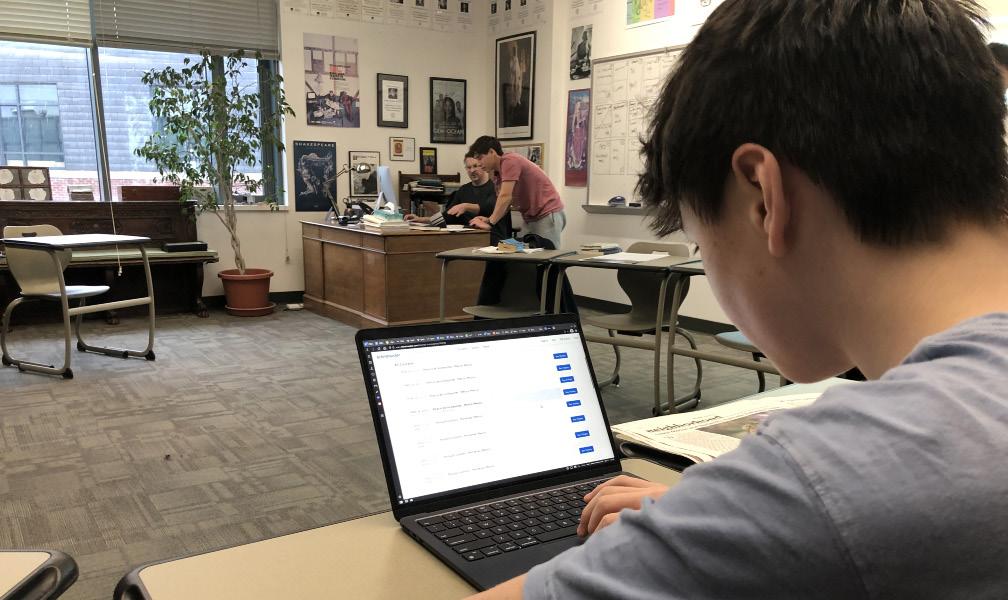
However, the general approach to the way pop quizzes are utilized at The Haverford School is highly problematic and defeats the greater goals of learning. The purpose of pop quizzes should be reassessed by the teachers who make the unfortunate decision to administer them.
Teachers should return graded work faster
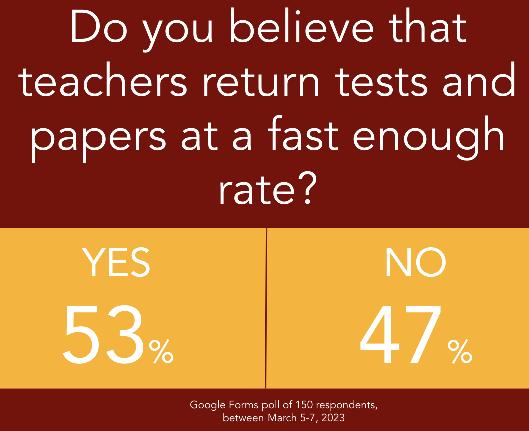
Why do teachers take so long to grade and return certain assignments?
This is a question that all students seem to ask and that has been around forever. Are teachers unaware of student frustra-
tion around the timeliness of feedback and simply going at their own pace, using their own grading system and returning work? Or are there other motives and reasons for this trend?
Currently, graded work takes too long
to make its way back to students. Teachers should aim to grade more quickly in order to provide students with more immediate feedback.
Students report that it can take over a month to get a paper returned, even though there are many benefits to more timely feedback. The sooner papers are graded, the sooner students can learn what they did wrong and how they can implement changes in future work.
English, history, and even science papers are generally graded very thoroughly and carefully, but that attention to detail takes time, which raises the question: is it better to grade more quickly, but potentially less effectively, or more slowly, but more carefully?
“There is a sort of debate among teachers about what matters more to students,” English teacher Ms. Emily Harnett said. “Is it having immediate feedback or thorough feedback?”
Ms. Harnett acknowledges that at Haverford teachers have a smaller student population than in public schools.
“Because it is possible to give fairly substantial feedback on every paper,” Ms. Harnett said, “we choose to do that rather than prioritizing advantages of immediate feedback.”
Ms. Harnett notes that teachers have many constraints and demands on their time,
and sometimes one responsibility, (such as writing comments for progress notes) has to take priority over grading papers.
This response then raises another question: are teachers over-scheduled? If so, should the school prioritize grading student work first, and then other activities.
Given the many benefits of prompt feedback, if teachers are over-scheduled, the administration might want to consider putting a precedence on grading work first rather than other activities, especially since the majority of students would prefer it this way.
The benefits of more immediate feedback on student work can be seen in math classes. Students report that math teachers are generally faster at grading than other teachers. According to several current Algebra II students, the benefits of that quick feedback are huge: it helps math students figure out immediately what areas need improvement, what questions need to be asked, and where the weak areas are so that practice and review can be more targeted.
The student body as a whole will be more satisfied and will benefit more academically with a faster pace for feedback on assignments.
Teachers should return work back to students in a more timely manner. This is a small change in the community, but one that will help students succeed in high school.
Luca Aloi ’25
Grayson Morgan ’26
INDEX STAFF campus
the index · campus opinions March 2023 Page 19
Student prepares for a quiz
off-campus opinions
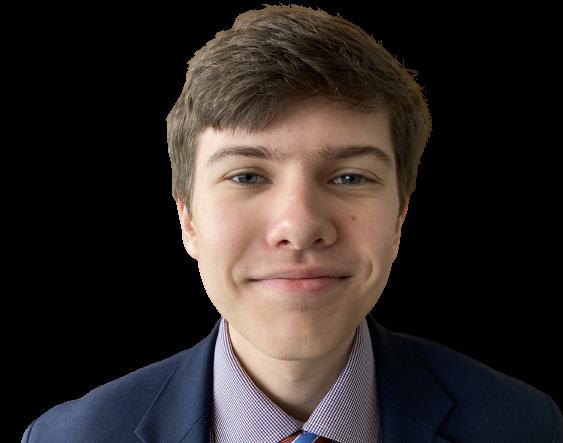
The dangers of the Ohio train derailment
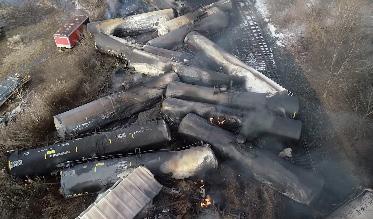
On February 2, 2023, one of the worst chemical disasters on American soil took place, and the media isn’t covering it enough. On this day, a train was carrying 150 cars, some of which carried hazardous materials. 38 cars were derailed in the town of East Palestine, near Ohio’s Pennsylvania border, eleven of which carried dangerous chemicals. After this incident, the Environmental Protection Agency decided that the best course of action would be to evacuate the city and then release the explosion-prone chemicals into a pre-dug trench, for a controlled burn.
Because the agency was burning chemicals such as vinyl chloride, isobutylene, butyl acrylate, ethylhexyl acrylate, ethylene glycol monobutyl ether, and benzene, the byproducts produced were less than ideal. The main concern of the residents of East Palestine was vinyl chloride.
When vinyl chloride combusts, it produces hydrochloric acid as well as phosgene. Of course, acid of any kind is not good in our atmosphere, as it would result in acid rain. Phosgene is also incredibly dangerous for respiration; in fact, phosgene gas was
used for chemical warfare in World War I. Breathing in phosgene results in coughing, nausea and vomiting, and even death. In addition, many of the chemicals burned either were carcinogens themselves or produced carcinogenic chemicals when combusted. This means that there is currently a great risk of cancer in East Palestine.
What happened after the burn? After these chemicals were released into our ecosystem, thousands of fish have been reported to be dying. In addition, residents of East Palestine have reported deaths of seemingly healthy pets.
Perhaps igniting the chemicals was the best course of action, but the EPA (Environmental Protection Agency) did not dispose of the contaminated soil and water in a proper manner. After the burn, the soil in the trench and near the trains that these dangerous substances touched were not disposed of. This then lead to contamination of waterways and other nature.
So why should we as students and faculty of the Haverford School care? There is a concern that the chemicals could make their way towards the Philadelphia area, considering how close East Palestine is to us.
However, more importantly we should take away that the handling of dangerous chemical substances is not treated as carefully as it should be in the U.S.
The EPA did not control this situation as they should have, and we should be aware of the fact that this is the worst-case sce-
nario. It’s possible that occurrences like this have been happening much closer to us at a smaller scale, but we have no idea.
This is just the news source that has been reported on, and now we have to be aware of the mistreatment of chemicals in our areas.
 Luke Ganley ’25
Luke Ganley ’25
NATIONAL TRANSPORTATION SAFETY BOARD VIA WIKIMEDIA COMMONS
Drone footage shows the freight train derailment in East Palestine, Ohio, U.S., February 6, 2023
the index · off-campus opinions March 2023 Page 20
arts
Behind the scenes of Les Misérables
max
On Friday, March 10 at 7:30 p.m., Haverford’s production of Les Misérables premieres in Centennial Hall. The show will feature profound acting, a detailed set design, and eye-catching costumes. It has been a long time since Haverford performed this show.

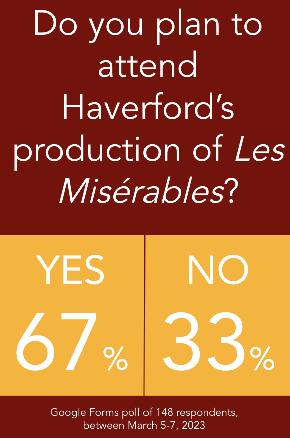
According to director and Performing Arts Department Chair Mr. Darren Hengst, what makes Les Misérables stand out from other productions that the school has done in the past is that “it’s a completely sungthrough show, so there is no moment in the show without music.”
Mr. Hengst also mentioned the large and impressive set design.
“It takes place in a lot of different locations, so the stage crew has been working hard trying to deliver them for us,” Mr. Hengst said.
Mr. Hengst gave a preview of the show’s plot. (Warning: some spoilers ahead).
“In the first scene of the play, we see a chain gang,” Mr. Hengst said. “A prisoner is freed that day, his name is Jean Valjean, and he tries to transition back into life after he has been away for nineteen years on the chain gang. He is on parole, tries to get work, and tries to contribute. Because he is on parole, he has to show papers, so it is difficult for him to get a job or find a place to stay. What he decides to do is break his parole and change his identity, and try to live life. Ten years later he is the mayor of a town, and he runs a lot of the businesses in the town, the police officer that let him go, Javert, is still after him. And so he is always trying to create a life for himself, and he is always chased by this police officer.”
Mr. Hengst describes how this year’s performance of Les Misérables will be different from previous performances.
“The technology that we have brought in, in my time over the past ten years, is pretty significant, the enhancements in lighting and sound, and we will be using projections in this version,” Mr. Hengst said.
The students were cast into their roles in December and have been practicing ever
since they returned from winter break.
“The amount of vocal training that is needed outside of rehearsal is tremendous,” Mr. Hengst said. “The way students practice for the play, they have to learn the music first, they need to understand the music and the story of the screen, and they work with Mr. Mastronardi [the show’s music director] on the music of the scene. And after the music is down, then I stage it.”
Every interaction between actors onstage is important.
“One of the themes in this is a type of brotherhood that they carry with them from the beginning of the show. For me what is interesting is seeing the actual relationships on stage with these guys, and making sure that comes out to the audience.”
Both Mr. Hengst and the students agree that the scene of community is in the show and behind the work of the show. “There is this week called tech week where we have rehearsal every day and we get to work with each other every day and see everybody ev-
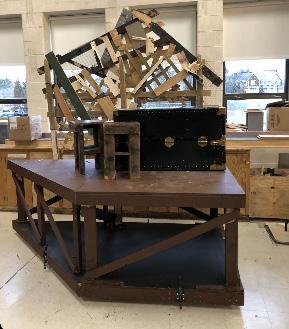
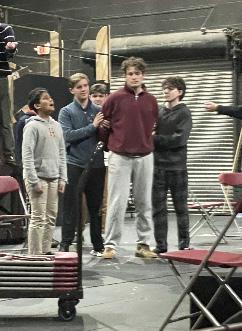
ery day, and that is when the fun happens and we get to build this community that everyone likes each other,” Sixth Former Jack Squillaro, who plays Inspector Javert, said.
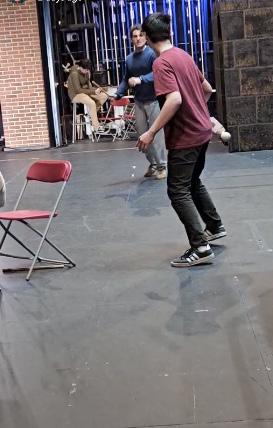
“It’s really nice performing, and the supportiveness of the bigger kids really helps me when I perform,” Leo Sides, a lower school student who plays Gavroche, said.
The costume department is run by Fifth Former Jai Bonaparte.
“It is really easy to portray elements of the story through fabric choices and colors and patterns. A lot of the fabrics are red, blue, and white because it is [set in the early nineteenth century],” Bonaparte said.
“The main thing that the set is supposed to be there for is the [early nineteenth century], so we have cobblestone flooring, we have a rustic barricade thrown together with piles of trash that we use,” Carillo said.
Like in the costumes, set design also uses colors to express the mood.
“It’s like mainly dull and dreary colors,
Many fabrics are distressed to show the age of the clothes and social class.
“With a lot of the newer costumes, what we do is we pick from older costumes, and we’ll take them apart and use them to make something else,” Bonaparte said.
Sixth Former Jonathan Carillo serves as stage manager. He participates in a variety of jobs including set design, sound and lighting cues, and cast movement. For the set, he has worked on the barricade and the towers along with other objects and set pieces.
like brown, gray, and black, since at the time things weren’t the best,” Carillo says. “There is also a group of slaves that got branded, who are working throughout the show with a few other pieces during it, and that gives you the historical context of how prisoners were treated more like slaves than people.”
sides ’26
Students rehearse a scene of Les Misérables March 7, 2023
LOGAN SCHLITT RIYAD ROLLS
the index · arts March 2023 Page 21
A group of Fords rehearse
’26
A piece of the set known as “the barricade”
Jack Squillaro ’23 and Harvey Pennington ’23 rehearse a fight scene
SEBASTIAN GOLDERER ’24 JONATHAN CARILLO ’23
“It’s really nice performing.”
LEO SIDES ’32
Oscars 2023: preview and Best Picture predictions
The 2023 Oscars are right around the corner, and Hollywood looks to celebrate a year of cinematic excellence. Although viewership of the annual awards show has declined considerably over the years (down nearly seventy percent from 2014), this year’s nominees hope to see their work recognized before millions of viewers, particularly in the most prominent award: Best Picture.
This year’s nominees are: All Quiet on the Western Front, Avatar: The Way of Water, The Banshees of Inisherin, Elvis, Everything Everywhere All at Once, The Fabelmans, Tár, Top Gun: Maverick, Triangle of Sadness, and Women Talking. All ten films have plenty to offer, but a few have separated themselves from the pack as realistic contenders.
Highlighting the war genre in 2022 was the brutal World War I epic All Quiet on the Western Front, directed by Edward Berger and adapted from the 1929 novel from German veteran Erich Maria Remarque. The film’s quality is undeniable, but it suffers from the typical war movie curse: it has nothing to separate itself from the classics. For an anti-war message exposing the dehumanizing absurdity of war, turn to Full Metal Jacket or Apocalypse Now; for a grim, realistic depiction of warfare and its violence, look no further than Saving Private Ryan or The Deer Hunter. The modern-day war film must have a defining quality—see Dunkirk’s manipulation of time and perspective, or 1917’s “one take” effect. All Quiet on the Western Front deserves an audience and a great deal of praise, but it lacks the creative firepower to cement itself as an anti-war classic.
Within the final months of 2022 emerged two dark-horse candidates for Best Picture: Steven Spielberg’s The Fabelmans and Todd Field’s Tár. Spielberg’s bildungsroman is a love-letter to cinema itself, following adolescent Sammy Fabelman in his introduction to cinema. The Academy has a propensity for awarding films about films, so do not be shocked if they give one of their
golden boys the nod for his most personal film to date.
Across from the sweet, nostalgic tale in The Fabelmans is the ruthless and deeply disturbing psychological drama in Tár. Cate Blanchett delivers a powerhouse performance as classical music composer Lydia Tár in Todd Field’s return to the big screen after sixteen years. The film was initially met with mixed reactions, with some praising it as a masterful exploration of corruptive power, and others criticizing its meandering nature and confusing emotional center. As time wears on, history is likely to look kindly on this film, which boasts some of the most riveting storytelling of 2022. Its chances for Best Picture, though, remain slim.
In the blockbuster category, Top Gun: Maverick surprised audiences by producing a perfect balance between paying homage to the original while still telling a fresh story with compelling characters. Surviving the label of a lazy legacy sequel, the spectacle was heavily praised upon its initial release, with some even hailing it as the savior of the action genre, much because of its dedication to practical effects. While Tom Cruise soared to new heights as the returning Maverick, and Miles Teller achieved stardom as the lovable Rooster, this is ultimately no more than a solid action movie. It deserves recognition for producing something of value in a deteriorating genre, but it holds nothing special to lift itself above the other nominees.
The cinematic world was blindsided in March 2022 when Everything Everywhere All at Once hit theaters. The clear favorite for Best Picture, the film is a trippy, dazzling, and, most importantly, heartfelt journey.

Michelle Yeoh stars as Evelyn, an ordinary woman who owns a laundromat and struggles to pay her taxes. Everything changes for Eveyln when she is inexplicably swept up into an adventure through the multiverse. It is nearly impossible to describe this film, and perhaps that is what makes it special; at times viewers are simply left staring at the screen utterly dumbfounded at what they are watching, wondering to themselves, “How on earth did they film this?”
Martin McDonagh’s The Banshees of Inisherin is the greatest film on the nomination list.
Banshees includes some of the most stunning cinematography, captivating acting, and brilliant storytelling of the year.
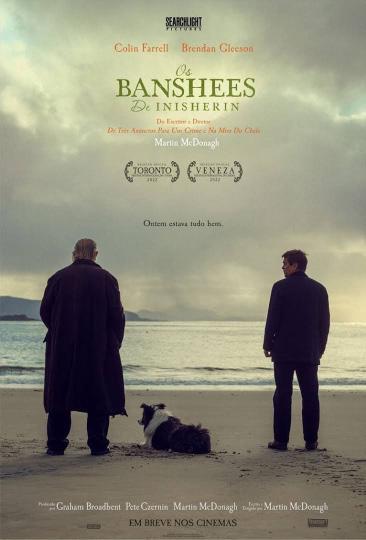
Every frame is carefully constructed and every second carefully measured, but McDonagh is not afraid to sit back and let the characters tell the story. Colin Farell delivers arguably the best performance of his career, and his chemistry with Brendan Gleeson is once again perfect.
Behind the inventive effects, comedic beats, and precise choreography, Everything Everywhere All at Once is a mother-daughter story. That is when this film is at its best— when it pulls back from the (admittedly entertaining) chaos of the multiverse and instead focuses on the difficulties of a healing parental relationship. Kwan and Scheinert’s sci-fi hit out of left field has little-to-no flaws, and it would not be disappointing to see it land the Academy’s most prestigious award, but there is one film with a slightly stronger case.
The moment when The Banshees of Inisherin lets its audience know how great it will be is when Gleeson’s character (Colm) plainly says to his ex-best friend, “I just don’t like you no more.”
McDonagh masterfully balances comedy and tragedy, and he allows his actors to show off their talents in an endless stream of superbly-written dialogue. The characters grapple with purpose, humanity, and history in this downright depressing portrayal of an ended friendship.
What separates Banshees from the other nominees is its ability to meditate on complex and potentially overwhelming topics while never losing sight of its deeply human characters. It does not need a ten-minute CGI sequence with wormholes and flashing lights to show the audience that a character is feeling lost. It is quiet, lonely, and deeply moving.
Everything Everywhere All at Once will likely win Best Picture due to its magnificent spectacle, but make no mistake—The Banshees of Inisherin was the best picture of 2022.
VIA SEARCHLIGHT PICTURES VIA A24
Adiyan Nayak ’24
Behind the inventive effects, comedic beats, and precise choreography, Everything Everywhere All at Once is a motherdaughter story.
Banshees includes some of the most sunning cinematography, captivating acting, and brilliant storytelling of the year.
the index · arts March 2023 Page 22
Everything Everywhere All at Once
Poster for The Banshees of Inisherin
Poster for
Rihanna: How a teen from the islands became a global phenomenon
 Liam French ’25
Liam French ’25
On the island of Barbados in 2004, at just sixteen years old, Rihanna was discovered by American producer Evan Rodgers. She came to America and recorded a four-track demo that was later sent to Def Jam Recordings. At the time, Jay-Z was the head of Def Jam, and after first meeting her, Jay-Z told Rolling Stone “I knew she was a star.” During the meeting they joked that she couldn’t leave until she signed a record deal.
“I had butterflies. I’m sitting across from Jay-Z. Like, Jay-Z. I was starstruck,” Rihanna told The Guardian
At seventeen, Rihanna released her debut album Music Of The Sun. The stand-out track of the album, “Pon de Replay,” pays homage to her Caribbean home as a pop track infused with elements of reggae. It ended up reaching No. 2 on the Billboard Hot 100 in 2005 and selling two million copies.
Over the course of the next ten years, Rihanna put out groundbreaking work. Her iconic 2007 album Good Girl Gone Bad marked a turning point in her career. This was when she finally started taking control of her music and moved away from the teen popstar image.
If someone didn’t know who Rihanna was before hearing “Umbrella,” they would surely know who she was afterwards. She released the smash hit featuring Jay-Z, which won the MTV music video of the year. At the Grammy’s that year, it also won the best Rap/Sung collaboration award while it was nominated for Song and Record of the Year. In addition to “Umbrella,” Good Girl Gone Bad features hits such as “Don’t Stop The Music,” “Shut up and Drive,” “Disturbia,” and “Take a Bow.”
This album led her fans to give her the nickname “Bad Girl Riri.” Her following two albums, Rated R and Loud, spawned multiple hits and established Rihanna’s discography as essential nightclub music that would carry the clubbing scene through the 2010s. Hits such as “Rude Boy,” “Te Amo,” “S&M,” “Only Girl In The World,” and the single “Love the Way You Lie” dominated the dancefloors. During this time, Rihanna created her trademark “R” that could be found on the covers of singles and her albums. This was most likely a push from her
lable’s branding or marketing team as a way to turn her into a living logo, one of the double-edged swords musicians face in the industry.
As Rihanna’s career carried out into the 2010s, she released multiple Billboard top10 hits such as “We Found Love,” the ballad “Stay” with Mikky Ekko, “Diamonds,” “Where Have You Been,” “FourFiveSeconds,” “This Is What You Came For,” “Needed Me,” and “Work.” “We Found Love” and “This Is What You Came For” helped boost Scottish DJ Calvin Haris into stardom. “We Found Love” became the longest running No. 1 single of 2011, and “This Is What You Came For” reached No. 3 in 2015.
Commanding the audience with her 2015 single “B**** Better Have My Money,” Rihanna opened the Super Bowl LVII Show atop a pyramid of floating platforms.
Rihanna’s eighth studio album ANTI was released in 2016 and has since become a fan favorite. It features the unforgettable and heartfelt ballad “Love On The Brain,” which tells the story of an abusive relationship of love that many people believe is about her former boyfriend Chirs Brown. Additionally, the song “Work” with Drake added to the rising popularity of twerking in mainstream media. Its smooth sound and unfiltered vocals make it one of Rihanna and Drake’s best collaborations. Another standout song from the album is “Needed Me.” At its core, it serves as a female empowerment anthem. It peaked at No. 7 and spent 16 weeks in the top 10. It went on to stay on the Billboard charts for 46 weeks, becoming Rihanna’s longest charting song. At the Grammy Awards, ANTI was also nominated for Album of the Year, but it unfortunately lost. After the release of ANTI, Rihanna went on a musical hiatus to focus on Fenty Beauty, her makeup and fashion line.
years, Rihanna fans were thrilled to find out that she would be featured on and producing the Black Panther: Wakanda Forever soundtrack. On October 28, Rihanna released “Lift Me Up,” a tribute to the late Chadwick Boseman. With Black Panther’s many Oscar nominations, Rihanna isrumored to be performing at the Oscars. This would be exactly a month after her highly anticipated Super Bowl LVII Performance.
While it was incredible to see Rihanna perform again, it felt sub-par.
Commanding the audience with her 2015 single “B**** Better Have My Money,” Rihanna opened the Super Bowl LVII Show atop a pyramid of floating platforms. She wore a red suit matching the platform
below her in contrast to the ensemble of
suited white dancers. She floated down and transitioned to “Where Have You Been” and “Only Girl In The World,” dancing to the best of her ability in her pregnant state. “We Found Love” transitioned to “Rude Boy” as her dance ensemble moved down a catwalk. Following this, Rihanna strutted down the catwalk followed by her dancers moving in the oddest way possible, which sparked a trend on Tiktok where users recreated this dance. Then, the entire dance ensemble ran out on the field for “All Of The Lights” with spotlights and cameras flashing all over the stage. “Run This Town” followed suit. During the break between that and “Umbrella,” Rihanna paused for product placement while applying Fenty Beauty. For the finale, Rihanna delivered a full performance of her hit song “Diamonds” while suspended above the field.
While it was incredible to see Rihanna perform again, it felt sub-par. It didn’t feel like she was giving all her energy to the melody of her discography. Her performance was dance intensive, and she managed to deliver the best she could. While building hype for the performance, Rihanna stated that it would be very special and there would be lots of new surprises. Well, she was right. The floating platforms have never been used before in a Super Bowl halftime show, but the special guest she said she was going to bring out never arrived. It is sad because some of Rihanna’s best songs are collabs with other artists. She could have brought out Drake, with whom she has five well-known and well-received songs.
After her Super Bowl performance, her music began to resurface on the Billboard charts, bringing about a new generation of Rihanna fans. Many fans now speculate she will release new music.

Family comes first for her. She most likely wants to be there for her kids as a young mother and be able to spend time with them before she has to return to her life in the industry. She hasn’t revealed the name of her unborn son yet.
Rihanna stated that she intends to release new music in 2023. So until that happens, fans will continue to stream her music and marvel at how a girl from Barbados went from entering a talent competition because her friends dared her to working with JayZ, becoming a billionaire fashion and beauty mogul, and being named the most influential Artist of the 21st Century.
WIKIMEDIA
WIKIMEDIA
the index · arts March 2023 Page 23
Rihanna sings during The Concert for Valor in Washington, D.C. Nov. 11, 2014
Barbadian singer Rihanna at the Met Gala in 2017
Campus reacts to 2023 Grammys
Another Grammys season has passed, and this year’s show was filled with just as many surprises and memorable moments as any other year.
Trevor Noah hosted the show once again at the Crypto.com Arena in Los Angeles. The night’s most nominated artists were Beyoncé with nine nominations, Kendrick Lamar with eight, and Adele and Brandi Carlile, each with seven.
The winners this year came as a surprise to most of the Grammy’s viewers.
The winners this year came as a surprise to most of the Grammys’ viewers. The award for Record of the Year was the least shocking, as it went to Lizzo for her #1 hit “About Damn Time,” which was inescapable on TikTok and the radio throughout the later half of 2022. However, it did beat out Adele, Beyoncé, Kendrick Lamar, Doja Cat, Harry Styles, and Steve Lacy, who all had tremendous hits this year as well.
The nominees for Best New Artist this year did not have as obvious a winner as they often do. Typically there are one or two artists nominated in the category that reached a huge level of success above the other nominees. Previous winners have included The Beatles, Mariah Carey, John Legend, and Billie Eilish. However, this year there seemed to be a relatively equal playing field. Samara Joy, an up-and-coming young jazz artist took it home against fellow nominees like Latto and Anitta, who had successful years, but no one really stuck out in terms of success.
Song of the Year was the biggest shock for most viewers.
Song of the Year was the biggest shock for most viewers. Huge contenders were in the mix this year including Adele’s hit “Easy On Me,” Beyoncé’s “BREAK MY SOUL,” Taylor Swift’s “All Too Well (10 Minute Version),” Kendrick Lamar’s “The Heart Part 5,” and more. However, even with all of these widely successful songs, the winner ended up being Bonnie Raitt with her single, “Just Like That.” For the viewers, this win was completely unexpected, even for Raitt herself, who seemed to be in disbelief when they called her name.
The final category of the main four, Album of the Year, is always the biggest award of the night, and it is considered to be the most coveted award in the music industry.
This award has gone to some iconic albums in the past by some of the greatest artists of all time. There are always high stakes for this category, and after last year’s Album of the Year surprisingly went to Jon Batiste, which upset many fans, no one knew what to expect this year. The nominees this year were ABBA’s Voyage, Adele’s 30, Bad Bunny’s Un Verano Sin Ti, Beyoncé’s RENAISSANCE, Mary J. Blige’s Good Morning Gorgeous, Harry Styles’ Harry’s House, Brandi Carlile’s In These Silent Days, Coldplay’s Music of the Spheres, Kendrick Lamar’s Mr. Morale & The Big Steppers, and Lizzo’s Special
Many fans wanted to see Beyoncé take the award home, as she has never won it despite her many critically acclaimed and impactful albums. However, the award went to Harry Styles, who was not the expected winner by most, but he was definitely one of the top contenders after his huge year.
Fifth Former Anthony Carter expressed his frustration with Beyoncé losing.
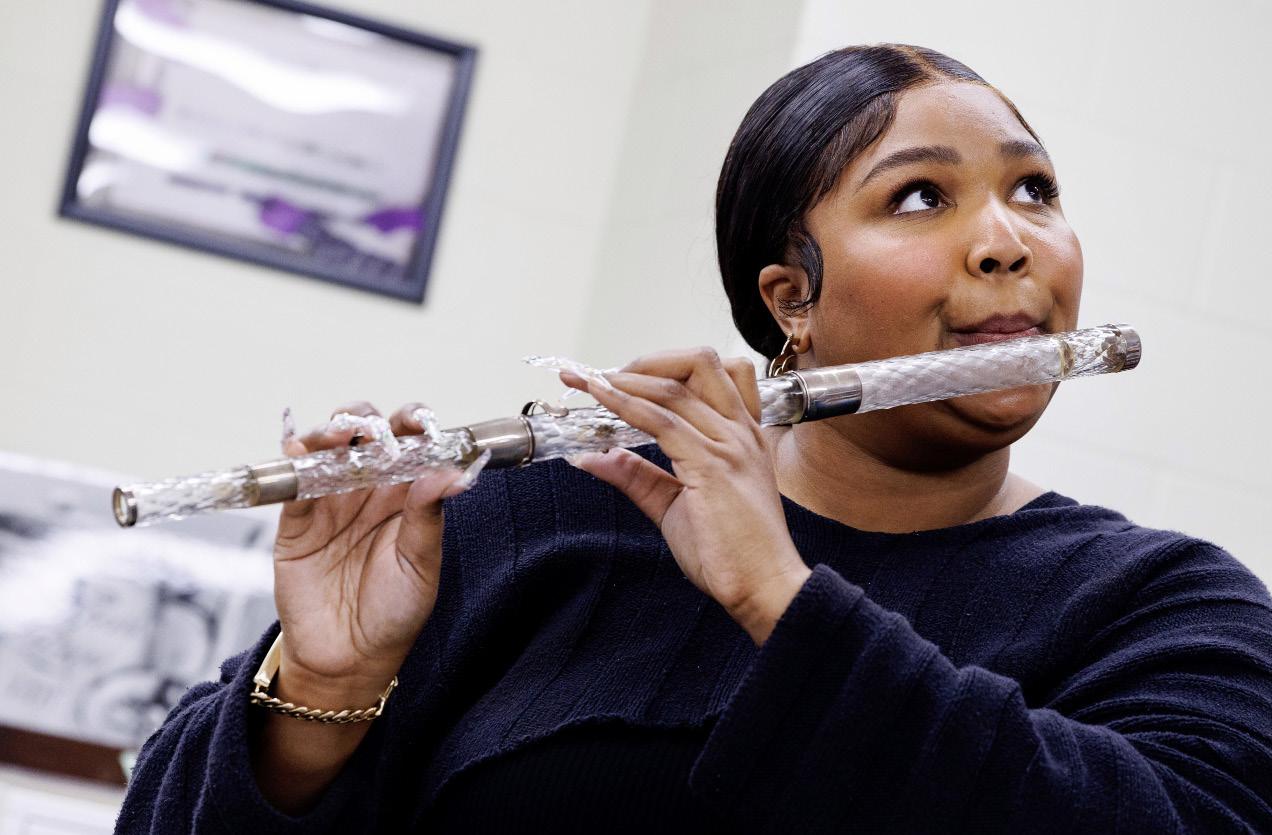
“She had the most critically acclaimed album of the year according to most major publications and articles and one of the most influential,” Carter said. “She took a Blackoriginated genre of music, dance, that has now been transformed into a mostly white genre, and took it back into her hands. It totally deserved Album of the Year based on the art alone.”
Many were also upset by the fact that there are so few Black winners in the main
four categories historically at the Grammys, especially in the Album of the Year category.
“Black artists are always getting snubbed of the Big Four,” Fourth Former Liam French said. “Only eleven Black artists have ever won Album of the Year and only three of them were women.”
Furthermore, a Black woman hasn’t won the award since Lauryn Hill took it home in 1999 for her debut album “The Miseducation of Lauryn Hill.”
While Beyoncé didn’t win Album of the Year, she did achieve a huge feat in this year’s ceremony, becoming the mostawarded artist of all time at the Grammys. She has won 32 Grammys, and this year she won Best Dance/Electronic Music Album, Best Dance/Electronic Recording, Best Traditional R&B Performance, and Best R&B Song. This record was previously held by Georg Soltí, a British-Hungarian conductor who has won 31 awards.
Beyoncé fans and just music fans in gen-
eral were happy to see her achieve this.
“It is so impactful to see a Black woman like Beyoncé become the person with the most Grammys,” Carter said. “To have somebody achieving this who is so focused and determined about their career, who has a hand in their production, video shoots, outfits, tours, albums, writing, and singing, is so inspiring.”
 Grammy winner Lizzo plays President James Madison’s 1813 crystal flute in the flute vault at the Library of Congress, September 26, 2022
Russell Yoh ’24
Grammy winner Lizzo plays President James Madison’s 1813 crystal flute in the flute vault at the Library of Congress, September 26, 2022
Russell Yoh ’24
the index · arts March 2023 Page 24
Beyoncé at the Atlantis Hotel Show, January 2023
WIKIMEDIA
VIA WIKIMEDIA COMMONS
VIA
COMMONS
“It is so impactful to see a Black woman like Beyoncé become the person with the most Grammys.”
ANTHONY CARTER ’24
Lacrosse heads into season with focus
Each new spring season brings one of the most iconic aspects of the campus: Fords Lacrosse. For the past nine months, the team has been hard at work. Workouts, scrimmages, and practices have been an integral part of their training program, strengthening and developing the team.

“Playing together in the summer
and feeling confident going into the season.”
and then through the winter and fall, we’re starting to mesh well together. Everybody’s on the same page and feeling confident going into the season,” Fifth Former Jack Long said.
Sixth Former Wills Burt echoed
“The younger guys that we expected to have a good fall and good winter, they did exactly that. They’re going to do great and we expect big things out of them”
WILLS BURT ’23
that sentiment.
“The younger guys that we expected to have a good fall and good winter, they did exactly that,” Burt said. “They’re going to do great and we expect big things out of them.”
Not only has the team been working hard on the field and in the weight room, but team events like paintball and dinners have played a key role in developing team chemistry.
“Playing paintball as a group was a blast,” Assistant Athletic Director and Head Lacrosse Coach Mr. Brendan Dawson said. “They got to shoot me, which was fun for them, but I thought it was a fun way to get together outside of just the weight room and on-field stuff.”
One of the biggest strengths of the team heading into the season is its attitude and mentality, staying focused on what is right in front of them.
“We’ve talked a lot about just the atti-
“We’ve talked a lot about just the attitude and chemistry of the group. They are a very focused group right now, we just have to make sure we continue with that.”
MR.
tude and chemistry of the group. They are a very focused group right now, we just have to make sure we continue with that,” Coach
Dawson said. “If everyone is pulling in the same direction, we’re going to be able to weather the storm when it comes.”
One of the largest changes of each new
“I really love our group of seniors... They’re motivated, they’re sending the right messages, and they’re living it everyday.”
MR.
season brings the unfortunate loss of last year’s Sixth Form class, which played a critical role in bringing the Fords to the Inter-Ac Championship and a 14-6 record, but the team believes in this year’s group of Sixth Formers to step up.
“I really love our group of seniors,” Coach Dawson said. “I just think they’re a really connected class. They’re motivated, they’re sending the right messages, and they’re living it every day.”
Coach Dawson has been trying to send to the new leaders a message on the importance of leading for others, and seeing leadership as a collective, rather than individual, pursuit. One of the tools he’s used to implement that type of leadership has been his newly created Leadership Seminar.
“I’m a big believer in servant leadership, and that’s a lot of what we talk about in the seminar,” Coach Dawson said. “As a leader, it’s your job to serve the people that you’re leading.”
For the Sixth Formers, their last season is special to them, and they want it to be suc-
cessful.
“It’s bittersweet,” Burt said. “I’ve been here for so long, and lacrosse has been my world for so many years that I’m ready to leave, but at the same time, I don’t want it to end.”
The season itself will be challenging, as the schedule includes many teams out of the Inter-Ac league, but the Fords will take a different approach when it comes to their mentality.
“Every opponent is a big opponent,” Coach Dawson said. “One of the things we started preaching last year was that there are no big games, and yes, we play a challenging schedule, and there’s exciting contests and matchups, but if you’re focused on that, you’re focused a little bit on the wrong things.”
Fifth Form Team Manager Gavin Stamps shared a similar feeling.
“Coach Dawson says if we just go out there and play lacrosse for 48 minutes, it’ll go our way,” Stamps said. “A lot of the teams that we have on schedule this year, we played last year, that didn’t go our way, but that’s why there’s this year.”
Although the schedule looks chal-
“We’re super ready to start playing.”
WILLS BURT ’23
lenging, the team is excited to put their hard work and dedication on display.
“We’re super ready to start playing,” Burt said. “Just ready to start getting that first game jitters out. I think it should be a fun season.”
Last year’s team huddles before facing McDonogh on March 25, 2022
MR. JIM ROESE
Casey Williams ’24
“Playing together in the summer and then through the winter and fall, we’re starting to mesh well together. Everybody’s on the same page
sports the index · sports March 2023 Page 25
JACK LONG ’24
BRENDAN DAWSON
BRENDAN DAWSON
Netmen aim for continued success under new coach
As the 2023 spring sports season begins, the varsity and junior varsity tennis squads envision their fourteenth-straight Inter-Ac championship title. Previously led by Coach Antonio Fink, the team had enjoyed great success in the past decade. After cementing his legacy as a Haverford great, Coach Fink stepped down as head coach. Coach Fink left big shoes to fill, but there is nobody better to fill them than alum Zach Lieb ’15. With two National Doubles Championships, four All-DelCo awards, and an Inter-Ac sportsmanship award under his belt, Coach Lieb is a good fit for a team of dominance. Varsity Coach Ms. Stephanie Kantor and JV Coach Dr. Mark Gottlieb will coach alongside Coach Lieb in the upcoming season.
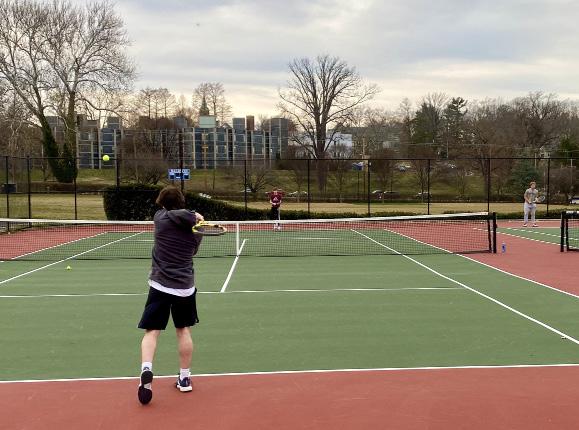
Coming off of an outstanding 12-1 2022 season, the team remains hungry to continue this winning streak into the opening April matches. The first varsity match of
the season will be against St. Joseph Prep. The Fords have not played against St. Joseph since the spring of 2021, where they won 7 - 0. The junior varsity squad is also set for a double rematch this season. Haverford played Germantown Academy once last spring and were defeated 2 - 5. However, given two opportunities against Germantown this year, one being played at home, the Fords will have a chance for revenge. Scores are not the only thing that are going to keep the players at their best. One of the most important factors for the team this season is the spirit produced by the players.
“I think everyone’s energy and positive spirit gives the team a special kind of camaraderie, and everyone enjoys playing together and cheering for their teammates. Every match and practice you see players getting fired up, and it really helps us stay intense but also have fun while on the court,” Sixth Former and Team Captain Jay Crowther said. “It is definitely one of the team’s biggest strengths.”
According to players, the brotherhood stimulates the energy within the team.
“At the end of the day, the wins and losses are not what keeps the team going.
The upbeat spirit is what makes it so special. It helps us take on challenges and figure them out as a group. The team is always going to have your back,” Sixth Former Thomas Pendergast said. “It encourages us to stay confident, but also motivates us to continue working hard.”
With the first matches only one month away, the Fords tennis team will continue working hard in preseason training. Small steps forward are all that matter at this point in the season, helping the team prepare for what is next in line.
Track and field boasts broad talent
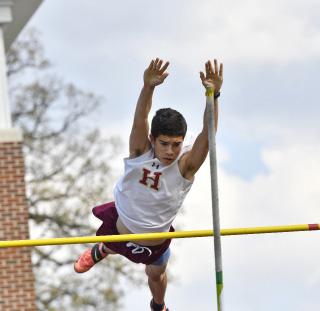
could find a diamond in the rough out of one of these new athletes. Only time will tell.
Though the track team will undergo several changes, the team at its core will stay the same. Coach James Hawkins, or “Coach Hawk,” will continue to coach the team. Alongside Coach Hawkins, coaching pole vault will be the familiar face of Coach Christopher Fox.
success. Fifth Former Andre Innis, Sixth Former Amani Brown, and Third Former Ahijah Goins will headline the mid-distance group. Last year, Innis broke two minutes in the eight-hundred meters. Any track aficionado knows what an incredible and rare feat this is. Despite his age, Goins is not far behind, having competed with the varsity team last year, while he was a Second Former. Miles and more miles. A perfect description of the training of a long-distance runner.
Haverford has an incredibly deep field of long-distance runners.
The Fords track team has three runners who have achieved the impressive accomplishment of breaking five minutes in the mile: Fourth Formers Alex Dardarian and Will Suter, and Third Former Colin Toth.
The Fords’ track team looks to strike the ground running this spring. The majority of all track runners competed during the winter, meaning they have weeks of practice under their belts.
While the roster will remain similar, the team will undergo various tweaks. The team will miss Sixth Former Jaiden Shuchman, an experienced mid-distance runner, for their spring season. Shuchman will spend
his last season with the Fords on the baseball diamond. Shuchman’s loss will be tough, but the team boasts several key additions.
After his diving season, cross-country standout Fourth Former Will Suter will return to the track.
“I’m excited to make a return from injury this track season, ” Suter said.
As the school year draws to a close, several students flock to the track for the coveted last sports credit. Perhaps the track team
The Fords have a well-rounded track team, with strong and promising athletes in all categories of events: sprinting, middistance, and long-distance. As most sprints are decided by tenths of a second, the margin for error is minimal. To combat this, the team boasts many experienced sprinters. The sprinting unit is led by Sixth Formers Chace Knox, Yasir Denmark, and Zach Powell, who bring an exceptional level of experience and talent to the track.
Mid-distance runners are the “Jacks of all trades” of track and field. They require blazing speed, and great endurance to find
As there are many similarities between cross-country and long-distance track, many cross-country runners will make up the longdistance unit. Sixth Former Colin Kelly, Fourth Former Mason Weigand, and Third Former Jack Ford are hot off a grueling and intense winter training season. The distance unit is ready to tear up the track this season.
The field aspect of track and field requires perfect technique. Fortunately for the Fords, two of the field athletes qualified for States in the winter. Fifth Former James Gates will look to claim his spot as best in the Inter-Ac in pole vault. Fifth Former Jey Brown will also dominate the field, having qualified for states in shot put.
PIERCE LAVERAN ’24
Ryan Moran ’24 returns a serve at varsity tennis tryouts, March 3, 2023
James MacColl ’26
James Gates ’24 in action, May 2, 2022
COMMUNICATIONS
Colin Toth ’26
“The team is always going to have your back.”
THOMAS PENDERGAST ’23
the index · sports March 2023 Page 26
As there are many similarities between cross-country and long-distance track, many cross-country runners will make up the long-distance unit.
Squash cont. from front page
One of the highlights of the season was playing their main rival, the Brunswick School, beating them twice—once at home, and once away.
“We’ve never [beaten Brunswick] at [their] home before,” Coach Stait said. “It was tough in front of their crowd as they had their student section there.”
However, for the match at home, the team had a strong student section present, which propelled them towards their first victory against Brunswick.
“We have had a student section at almost every game, and the most important ones, which include our match versus Brunswick at home and vs. St. Andrew’s at Nationals, [the students] packed the stands, which no other high school in the country can do,” Kang said. “It was an electric feeling to have the Fords cheering you on from the stands, one really that I cannot forget for the rest of my life.”
to step up. Still, the team believes that they are prepared.
“A lot of [the rising upperclassmen] have been leaders anyway,” Coach Stait said. “So it’s gonna be seamless in that way. Our junior class brings the most depth we’ve ever had as a squash class. It’s going to be great to have them as seniors, but a big loss when we lose them.”
Matthew Kang echoed a similar statement.
to do anything for Fords squash. Owen and I learned so much from previous captains, and I know these guys [will do] the same as well.”
school squash season meant a lot to them, and having it be a successful one made the season all the more memorable.
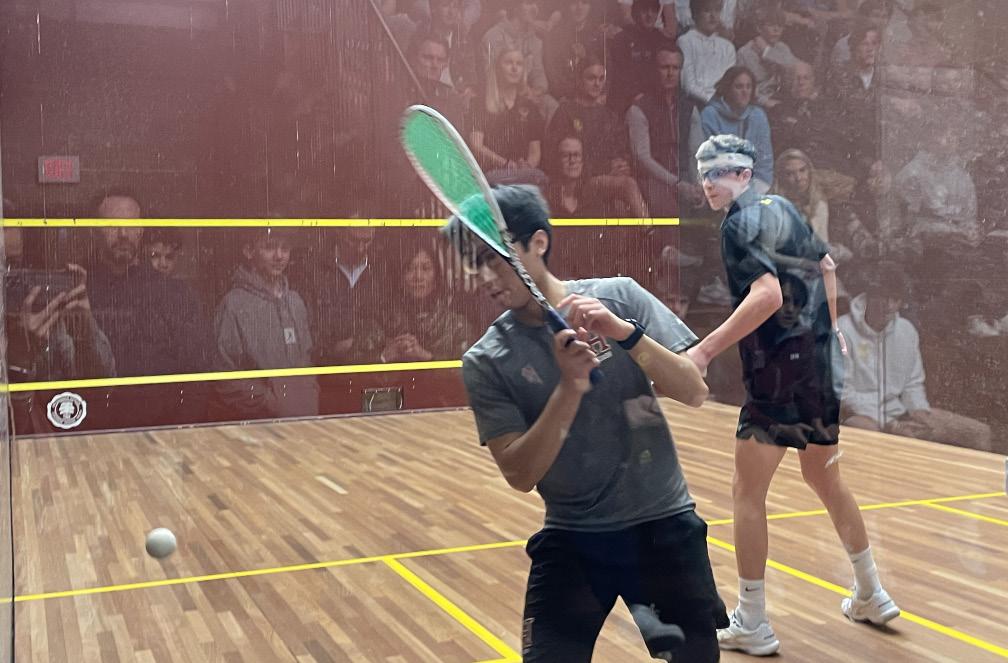
“Coming into the year, we had high expectations: to win the Inter-Ac, be a highseeded team at Nationals, and most importantly, carry on the respected Haverford legacy for another year,” Kang said. “Somehow and someway, we exceeded those expectations.”
The end of each season brings the inevitable transition that means Sixth Formers leave the team, and younger players will need
“I have so much confidence in the upcoming juniors. [Fifth Former] Drew Glaser has been on the team as long as I have, and been through the same hardships. I have the utmost confidence in him to continue leading the team by example,” Kang said. “[Fifth Formers] Graeme Herbert, Ethan Lee, Preston Wu, and Render Ford are all great players—people who are accountable and willing
“I think next year is just about being even more of a leader on the team,” Glaser said. “Making sure that they can rely on me each match to win—I need to be able to handle that.”
For the Sixth Formers, their last high
The not-so-Super Bowl for Philadelphia
The squash team’s accomplishments will mark them down as one of the best in the school’s history.
“We had one of the best Haverford Squash seasons ever, and I couldn’t be more proud of the guys,” Kang said.
“They deserve these results for how much work they put in. I guess all things must come to an end, and this is the best way it could’ve.”
Sunday, February 12, 2023, at 10:14 p.m. A painful time for Eagles fans.
In fact, this was the exact minute the opposing AFC champion Kansas City Chiefs emerged victorious, defeating the NFC champion Philadelphia Eagles 38-35 in Super Bowl LVII.
Although it was arguably one of the most exciting in Super Bowl history, the end was nothing short of heartbreaking. It felt as though Eagles fans were watching the game expecting to win. We knew we were the better team though we still came up just short.
Disregarding the outcome, there are many things to look forward to, such as the fact that we most likely found a franchise quarterback in Jalen Hurts, most of our offense and a decent amount of our defensive players are young and talented, and we have

a future of high draft picks thanks to the football genius Howie Roseman. However, that is (unfortunately) not what the focus of this article is.
The first half was excellent. Near-perfect if you ask me: Jalen Hurts came out on fire, and despite a costly fumble—which resulted in a touchdown for Kansas City’s Nick Bolton—he was still able to put 24 first-half points on the board.
Patrick Mahomes and the opposition, however, looked like they had a lot they needed to fix. They did score a respectable fourteen points by the end of the half, but seven of those were thanks to the aforementioned Hurts fumble. In addition to this, Mahomes was subject to multiple three-andouts in these final few minutes, and his already-hurt ankle appeared seriously injured
after a powerful tackle. The Eagles were rolling.
It looked as though they were going to come out for the second half with matched intensity, and continue to pour it on those poor Chiefs. Well… they didn’t.
The first drive of the second half for the Chiefs set the tone for the rest of the game. Patrick Mahomes drove down the field with ease, and Isiah Pacheco simply could not be stopped.
But it was not this drive that put a dent in Philadelphia’s game, it was Jonathan Gannon and our defense’s inability to make adjustments to stop Kansas City.
So this continued throughout the rest of the game, and even though Jalen Hurts was near-perfect, we still lost the game.
I don’t want to get too deep into the sec-
ond half because it is a touchy subject, but I cannot go without mentioning one of the most controversial calls in the history of the game. Eagles cornerback James Bradberry gently tugged on the jersey of Chiefs wide receiver Juju Smith-Schuster, and although it does technically qualify for a hold, the referee should not have called the penalty, as it ended up deciding the game. The result of this play has caused many to look at Bradberry in a bad light, but he should be looked upon in any way but that. He had an all-pro year, and is one of the reasons why we were able to get to where we did.
Well, for all of you sad Eagles fans, the moral of the story is: we have a lot to look forward to in terms of a bright future, and we will be back.
COURTESY OF MS. TRACY LEE
Owen Yu ’23 prepares to play a drive against a Brunswick School player, January 20, 2023
VIA WIKIMEDIA COMMONS the index · sports March 2023 Page 27
The Chiefs celebrate after beating the Eagles 38-35, February 12, 2023
“It was an electric feeling to have the Fords cheering you on from the stands, one really that I cannot forget for the rest of my life.”
MATTHEW KANG ’23
Tommy Saul ‘25
“They deserve these results for how much work they put in.”
MATTHEW KANG ’23
Baseball hopeful to swing in another gleaming season
Jac Campbell ’23 brings the heat in a 2-1 win to clinch the PAISAA Championships over Malvern, May 28, 2022
Last May, Fords Baseball was crowned 2022 PAISAA Champions after beating Malvern Prep at Villanova Ballpark. The team enters the new season with high expectations and even higher hopes.

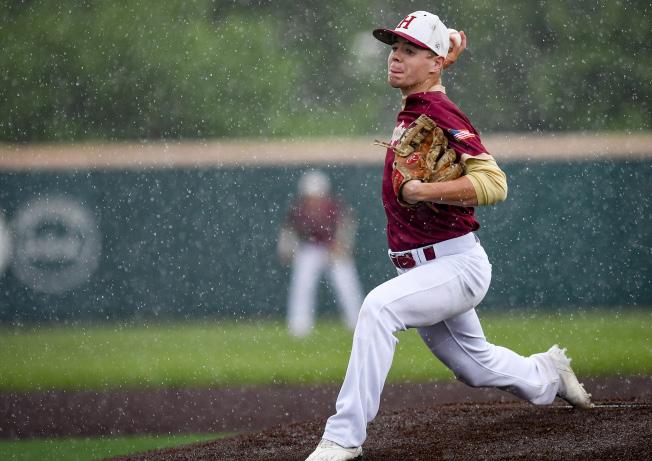
With many key players returning to the roster, the team feels like this year is theirs for the taking.
“Coming off a state championship, we have all the pieces to make that happen again this year. It’s going to be up to us upperclassmen to bring the new guys in and create a culture that brings us back to Villanova Ballpark,” Fifth Former Ian White said.
While the team experienced success in the state tournament last year, they struggled in the Inter-Ac. This year, the focus is on improving in the league. Division I recruits Cole Donnelly (Lehigh University), Ian White (East Carolina University), and Mark Quatrani (Cornell University) headline a roster that is determined to dominate in the Inter-Ac.
Off the back of a 3-7 record last year, White feels like the team still has something to prove.
“The emphasis on the Inter-Ac is definitely there,” White said. “We still have something to prove.”
This offseason, coaches Mike Palumbo and Tom McNeely stepped down as pitching and infield coaches. Coaches Luke Kania and Anthony Cimabue have stepped up and hope to lead the team to success. While Colby McNeely’s ’22 (Rider University) presence will be sorely missed, White will headline the Fords rotation alongside Sixth Former Jac Campbell (Norwich University), Fifth Formers Kevin Reavey, Fred Jordan, and Noah Trexler, and Third Former Jacob Horwitz. Campbell threw seven innings of one-run baseball in the State Championship game against Malvern.
Jordan and Reavey will see an increased workload in a busy schedule. Throughout the PAISAA tournament, Reavey came up clutch for the Fords with saves in both of the
Fords’ upsets at the Episcopal Academy and Penn Charter. Trexler comes into the year having featured sparingly at the varsity level in his first two years of high school, the sixfoot left-hander is intent on making his presence felt at the varsity level.
“I want to make bigger contributions to the varsity team this year, and I want to help us be successful,” Trexler said.
The other lefty at coach Bob Castell’s disposal is Third Form southpaw Jacob Horwitz. Horwitz made large strides in his development, featuring at regional showcases. Horwitz possesses an impressive fastball and two breaking balls—a changeup and a slider—that can fool batters.
Coach Kania hopes to find a group that can solidify itself. Sixth Former Ryan Getz’s imminent return should excite all involved with the program. Getz has missed both his Third and Fifth Form seasons due to COVID and an ACL injury. A high-octane player with a distinct feel for the game, Getz will look to return to his previous form where he hit .346 and drove in fourteen runs in the process.
Sixth Formers Joe Pennewill, Sean Dougherty, and Jaiden Shuchman who featured in platoon and bench roles last year will be asked more of by the Fords coaching staff. Dougherty in particular was vital to the Fords end of year bump, consistently driving the ball as a pinch-hitter in the back half of games.
Rounding out a group of outfielders is Third Former Jaidyn Rivera, who has impressed as a Third Former making varsity this season.
Infielders Coach Joe Martin will rely on Sixth Former Cole Donnelly and Fifth Former Connor Scanlan—two returning starters—to command a demanding infield. Atop the Fords lineup, Scanlan will build on last year’s campaign where he hit .292 with a .457 on-base percentage. The Fords offense will require Scanlan’s ability to get on base at a high clip.
Sixth Former Cole Donnelly announced
his commitment to Lehigh in February 2021 and struggled at the beginning of his junior season after seven months of rehab.
“It was definitely challenging not being able to swing a bat for the majority of my recovery,” Donnelly said. “Once I was cleared for playing I worked very hard to get back to the level I was at before surgery and that honestly didn’t really click until the summer.”
Donnelly delivered on continuous improvement. He shined in moments at the end of the season and was instrumental in the PAISAA championship run, flashing the leather multiple times in the final innings to hold off Malvern.
As a whole, the Fords are looking forward to Opening Day and the innate excitement it presents.
“We’re all excited to see what kind of start we can get off to. I think it’s imperative we start hot as it will give us something to build on as we head into the Inter-Ac season,” said Fifth Former Garrett Kriebel.
The non-conference schedule the base-
ball brass has put together will look to prime the Fords for the grueling Inter-Ac schedule in April and May. Tough tests against schools like Westtown, Perkiomen, and LaSalle will serve as the building blocks for the April 11th trip to Malvern Prep -- the Inter-Ac opener.
Sixth Form backstop Mark Quatrani committed to Cornell in July after he hit .389 and registered a 1.402 OPS as a junior. The Fords most potent hitter for much of last year’s season, Quatrani acknowledges the expectations coming to this year’s plate.
Still, Quatrani has made it clear that his main focus is to support his teammates on the mound.
“I’ll always have a lot of responsibilities, but my main priority is defense over all other aspects of the game. I’ve known these [pitchers] for a few years now and am very familiar with their repertoire and overall mindset on the mound.”
Quatrani’s relationship with the pitching staff will be key in determining the Fords success come late April and May.
Charlie Keidel ’24
the index · sports March 2023 Page 28 COMMUNICATIONS COMMUNICATIONS
Mark Quatrani ’23 at bat during the PAISAA Championships





















 Students lined up in The Café on a recent morning
JOEY KAUFFMAN ‘23
Students lined up in The Café on a recent morning
JOEY KAUFFMAN ‘23























 milan varma ’25
milan varma ’25









 Luke Ganley ’25
Luke Ganley ’25







 Liam French ’25
Liam French ’25


 Grammy winner Lizzo plays President James Madison’s 1813 crystal flute in the flute vault at the Library of Congress, September 26, 2022
Russell Yoh ’24
Grammy winner Lizzo plays President James Madison’s 1813 crystal flute in the flute vault at the Library of Congress, September 26, 2022
Russell Yoh ’24






